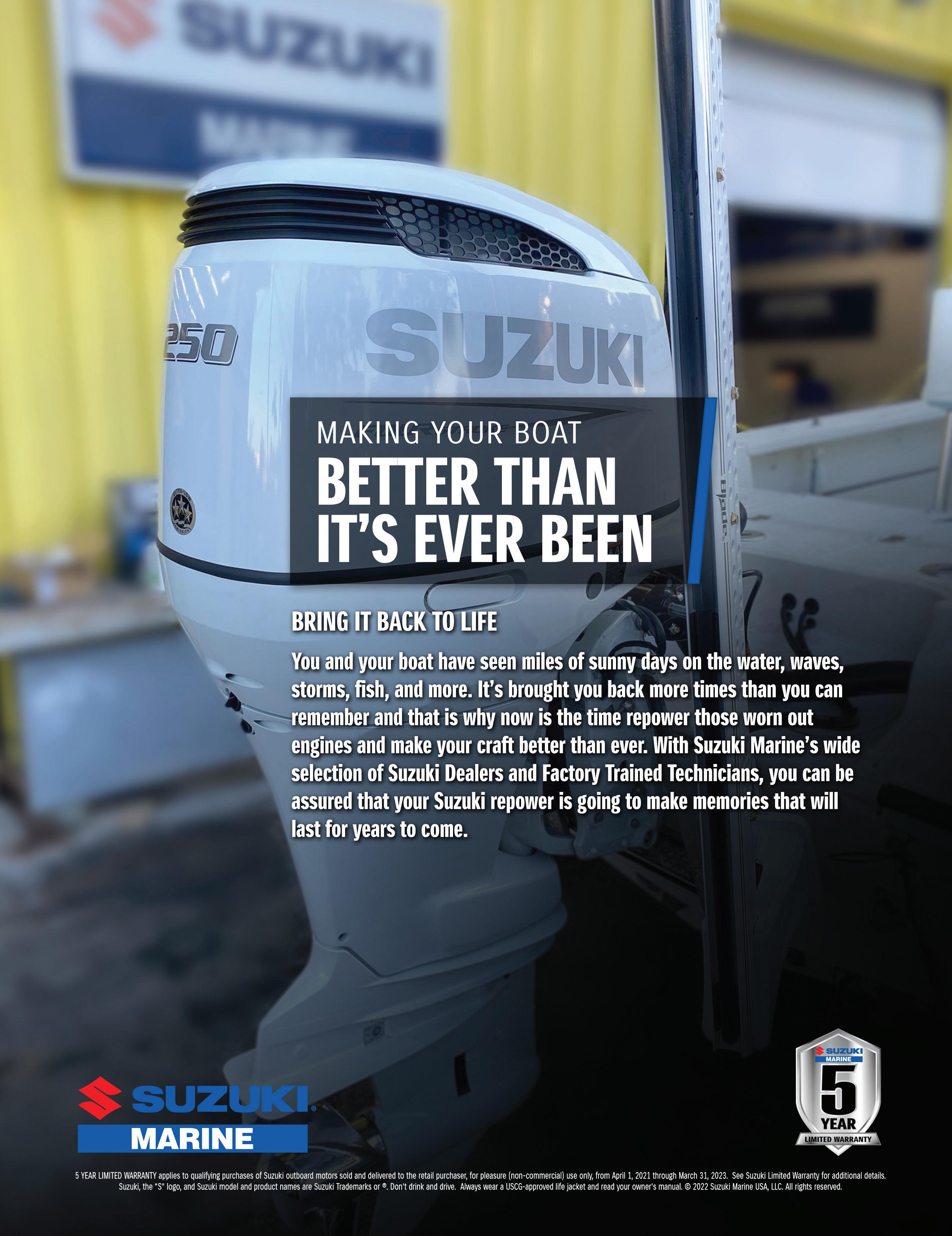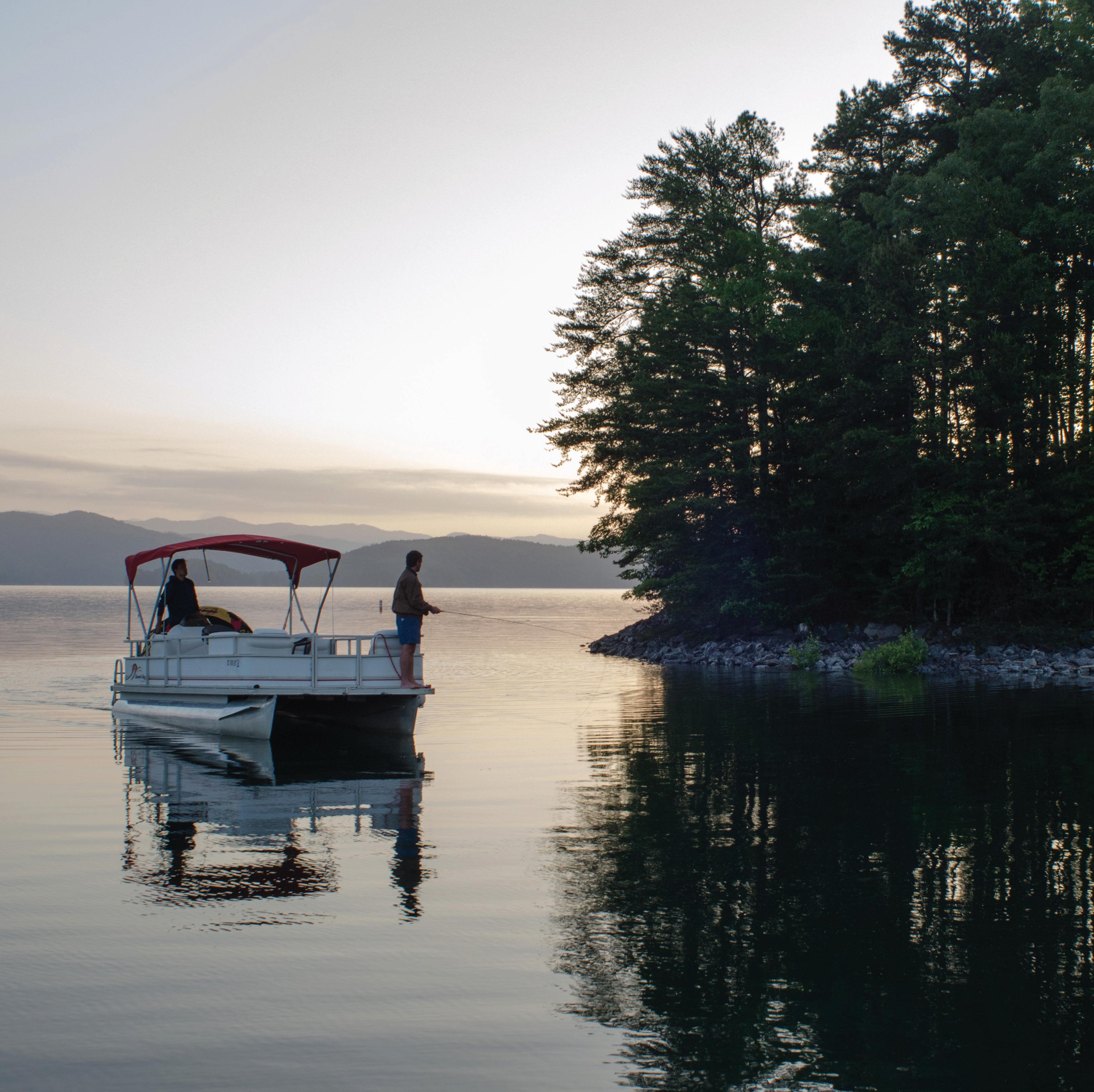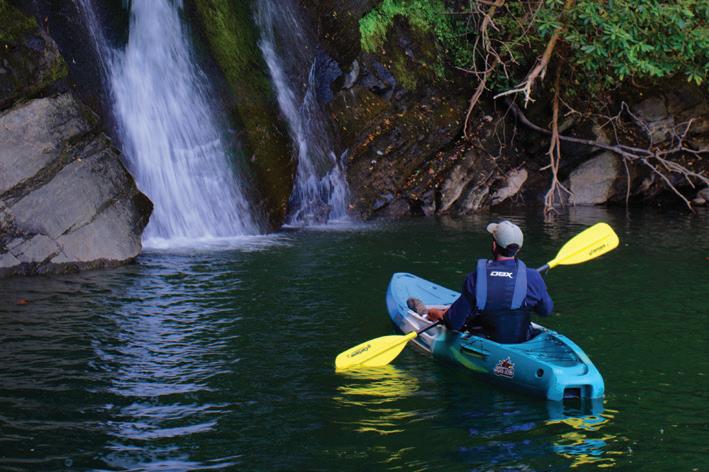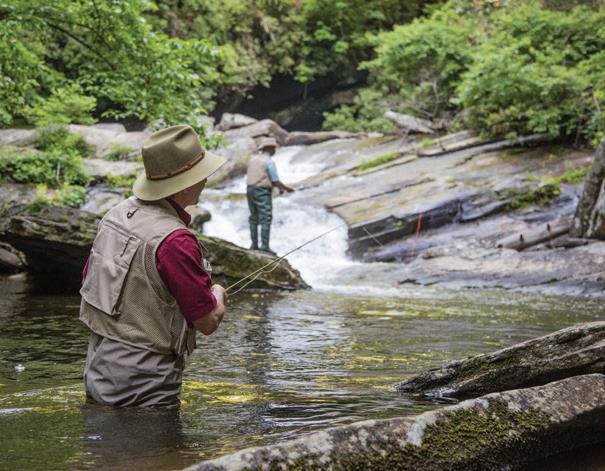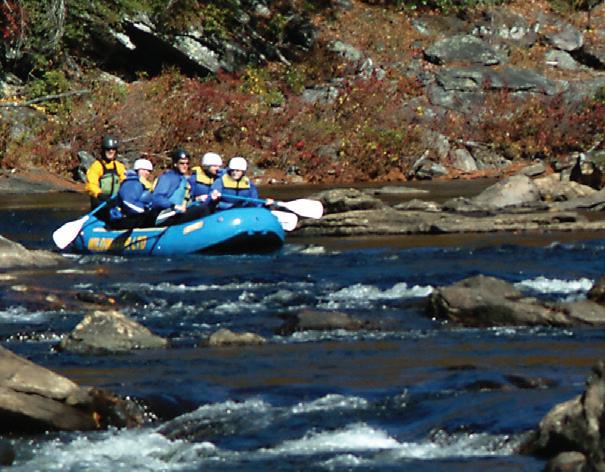
























































200-foot-deep structure.

Capt. Rick Croson, of Living Water Guide Service, showed Barefoot this bite for the rst time, and on that trip, they caught African pompano until they were tired of reeling them in as well as amberjack, dolphin and black n tuna. e widely accepted best way to catch African pompano is with a utter jig. However, Barefoot is never content with a tool or technique until he tries to nd a better way to do it.
“ ey are extremely susceptible to utter jigs, but the problem with those is the teaser assist hooks. We kept hooking them on the outside of the face with those wired stinger hooks,” he said. “With their thin, delicate skin, it’s tough to get a hook set. We were losing a lot of sh.”
e technique Barefoot settled on is to use his own 4-ounce Squid Decoy Jigs.
For most anglers, African pompano are welcome bycatch on bottom- shing trips for other species. But restrictive seasons on standard structure-oriented o shore species like grouper and snapper have made African pomps a primary target. In terms of gameness and quality as table fare, some might argue they belonged near the top of the list the whole time.
“ ey shut down grouper shing in January, and I’m not going to stop going o shore, so they’re the next likely candidate,” said Coastal Angler’s own Capt. Tim Barefoot. “ ey pull hard, they bite and they taste great. I’d put them
up in the top ve of my favorite sh to eat.”
African pompano school up on nearshore and o shore structure in late winter and early spring on the Atlantic and Gulf coasts. A couple of years ago, Barefoot was introduced to a ridiculously good bite for 15- to 45-pounders out of Wrightsville Beach, N.C., and what he learned might help you dial in the bite where you sh.
Cold water consolidates African Pompano to their comfort zone this time of year, and out of Wrightsville Beach anglers nd the magic 65- to 67-degree temps 45 to 60 miles out on 120- to

“African pompano are very close to the bottom,” he said. “We drop that squid down to the bottom and pull it up just a few feet. Sometimes you can just set it in the rod holder and wait for it to get slammed. Sometimes you might want to give some action, but don’t overdo it. Squid are their primary food source. When they see it, they’re not shopping… they’re buying.”
Barefoot uses 40-pound braid to an 80-pound uorocarbon leader. He ties on his jig with a loop knot. e thing about squid is sh always attack them from behind to disable their beak. Barefoot said sh take the squid jig deep, and the result is a solid hook set in the mouth.
Find Capt. Rick Croson at livingwatersoutdoor.com and check out the Squid Decoy Jig at barefootcatsandtackle.com.

With big trout on my mind, I hooked up the boat and headed to deep south Texas. An approaching cold front was going to shorten my trip to a single day, but I felt con dent it would be worth the 5-hour drive. As the cold front swept across north Texas, my anticipation was high as I headed south to warmer temperatures and extra hours before the frigid air and high-powered north wind turned a nice winter’s day into artic conditions. e morning greeted me with calm winds and dense fog, which is not typical south Texas

weather 14 hours prior to the strongest cold front of the year. e norm is 25 knots from the south or southeast with a storm of this magnitude on the doorstep.
I headed to my pre-determined location at a safe speed considering the conditions. I was in no hurry, as the prime bite was not until 10 a.m. e forecast was sunny, calm and 70 degrees for the day, followed by north at 35 knots and a low of 28 the next morning. I was certain the approaching weather would have the bite red up, and it did not disappoint. e sh didn’t feed on everything
I tied on, but once I homed in on what they wanted it was nonstop!
I pulled up to a favorite cove, positioned the boat well outside the prime area and quietly slipped into air-clear, knee-deep water of the grass at. I had a 5-inch paddletail ready at the end of my rod. A er covering the prime area with only one follow by a small red, it was time to change. I downsized to a 3.25-inch paddletail with a light purple back and a pearl belly. As I looked up a er rigging my lure, I spotted a huge trout about 5 yards in front of me. She was there for several seconds and then slowly disappeared. I knew she was aware of my presence even though she didn’t spook, and I didn’t have high hopes of catching her, but I did try. I was excited knowing my plan had me in the area of the trophy-size trout I was targeting.
I noticed nervous mullet about 40 yards away and slowly made my way in that direction. It was nonstop action on reds in the 26-inch range, and I caught one 3-pound trout. ese sh were a little deeper in thigh-deep, crystal-clear water over grass and potholes.
roughout the day, I tossed three sizes of similar body-style paddletails, all with built-in tail rattles. e smallest, a 3.25-inch lure, was the only one that caught sh. I used three di erent colors, so it was only the size that mattered on this day under pre-front conditions. Although I did not land the big trout I was targeting, I am satis ed that I was in the right place and will go back soon.
Capt. Michael Okruhlik is the inventor of Knockin Tail Lures®, and the owner of www.MyCoastOutdoors.com.
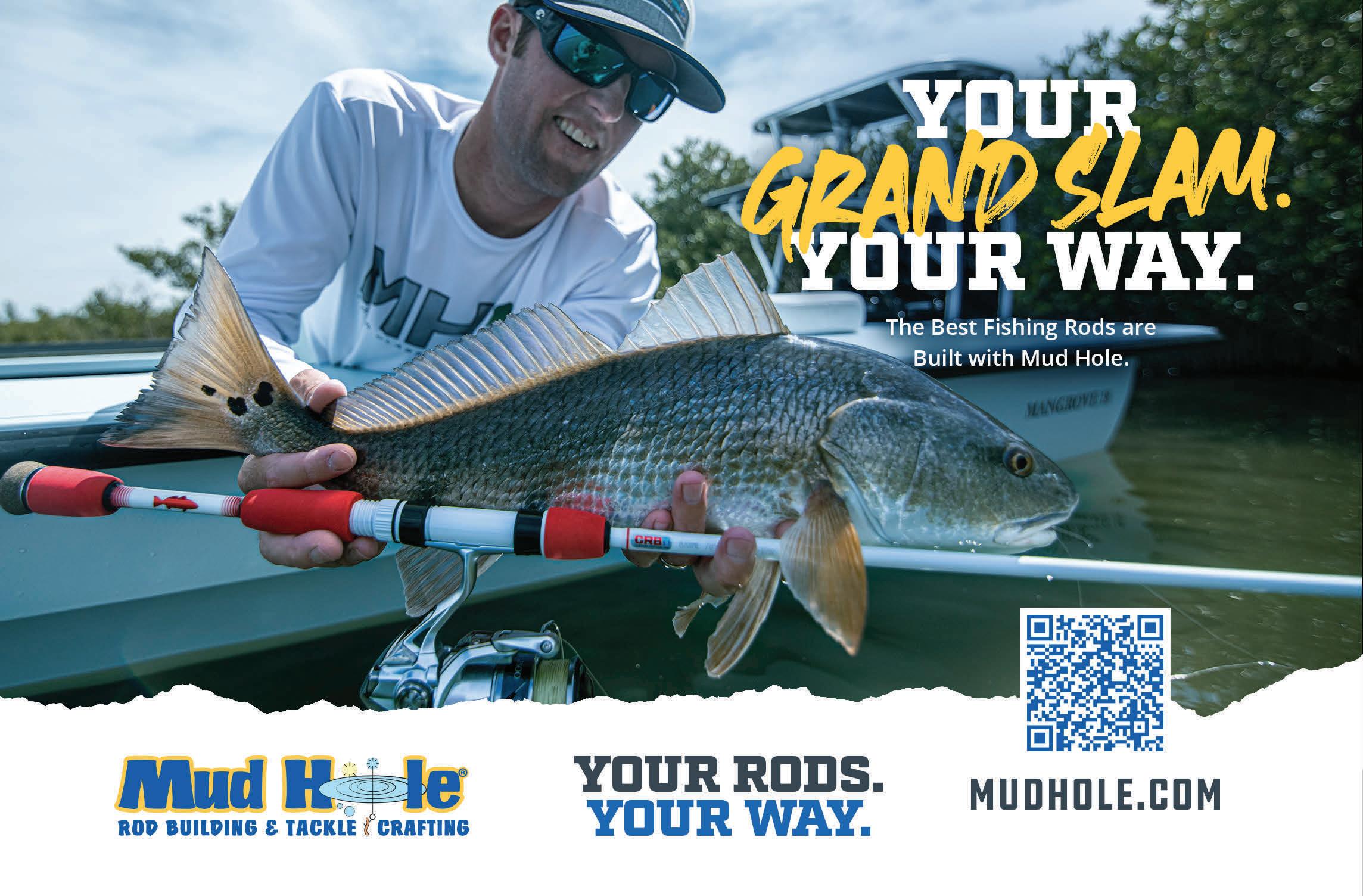
Some years ago, my girlfriend and I visited the Southwest town of Sedona. It’s a wonderful place. While jewelry stores, art galleries and upscale boutiques have crept into Sedona’s downtown, the air still maintains an electric charge. In one of these Sedona stores I acquired a Bowie knife that soon proved well worth the sticker price.
Disappearing into the stunning red rock formations that Sedona is known for, my girlfriend and I set out to hike Bell Rock, a butte just south of that famous desert town. We couldn’t have been happier.
Our happiness didn’t last long. Before we knew it, we stumbled upon a rather nasty diamondback rattlesnake. Acting quickly, I pulled my Bowie knife out of its holster and gave Mr. Snake a quick shave. We were lucky. Not only did my skill with a knife ensure our safety, but I had the makings for a new rattlesnake belt.



The next time something slithers too close, make sure you’re prepared with the Diamondback Bowie Knife. This 12" knife comes with a high quality 420 surgical grade stainless steel blade. The handle is made of genuine natural bone that’s been hand carved in the pattern of a diamondback. Completed with brass handguards, spacers and end cap and accessorized with a genuine leather tooled sheath, this is one blade a mamba won’t want to mambo with.






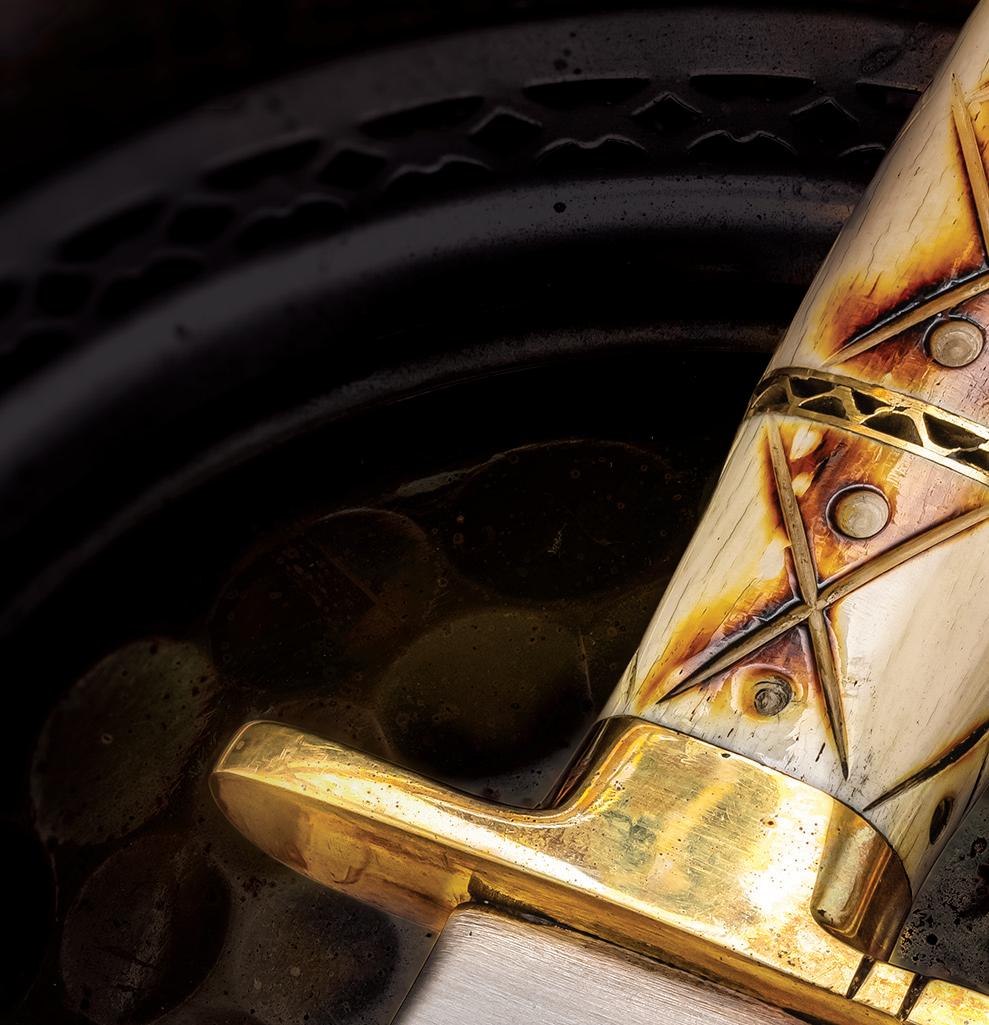


What’s more, while supplies last, we’ll include a pair of $99 8x21 power compact binoculars FREE when you purchase the Diamondback Bowie Knife. Simply put, this offer is an incredible bang for your buck. Act now: We only have 271 knives left for this ad! For your next adventure, don’t rely on some wimpy pocketknife to protect you from danger. Get the Diamondback Bowie Knife and come away with a story instead of becoming a snack.
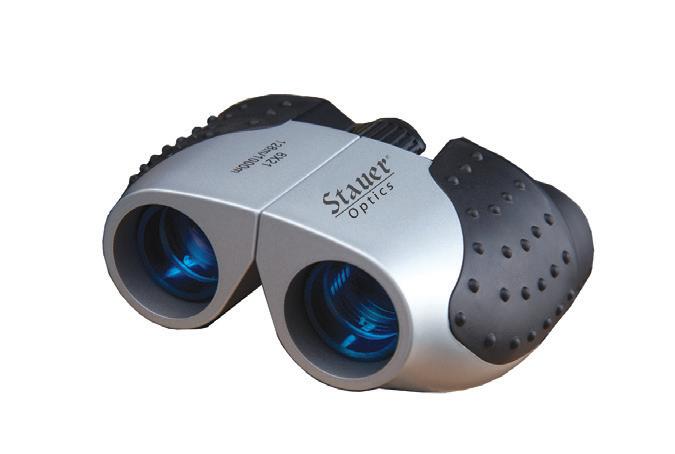


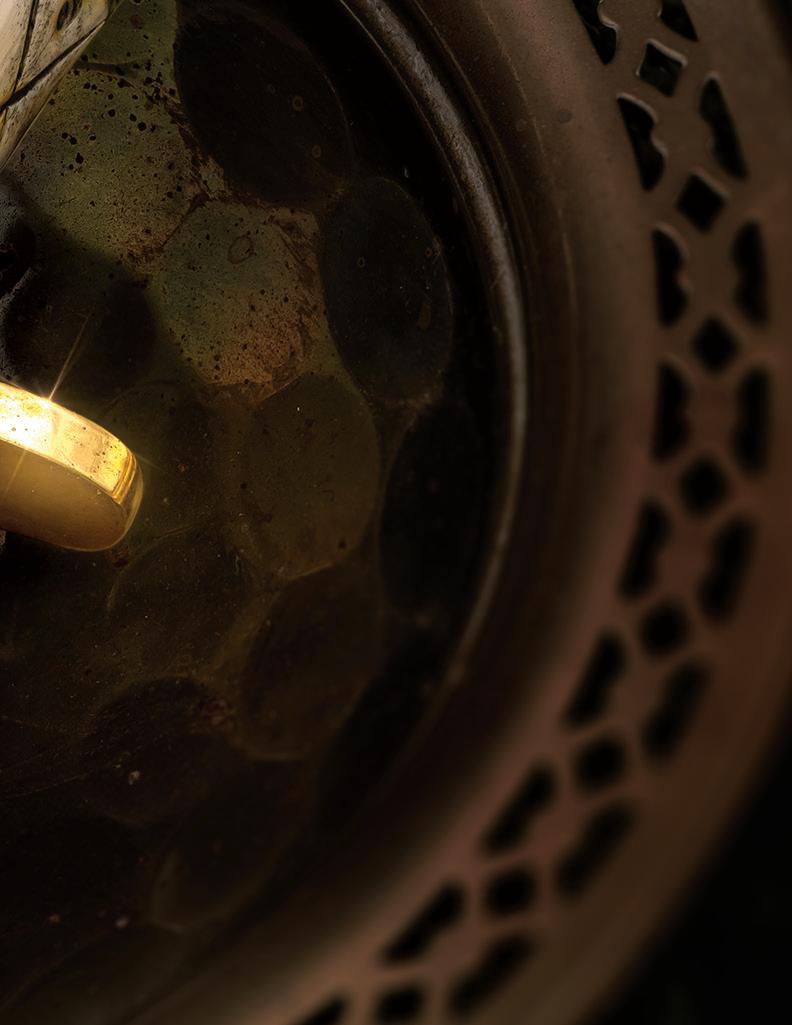



Asingle-handed y rod, which you might refer to as a “normal” y rod, is the tool of choice for most anglers seeking trout or other species on our inland rivers. But I’m here to tell you there’s a revolution building steam. Don’t be surprised when someone on your local river shows up wielding a two-handed spey rod. ese long rods are gaining popularity because they o er certain advantages.
For centuries, two-handed spey gear has been used only in pursuit of big anadromous sh such as salmon or steelhead on the huge coastal rivers of many continents. However, in the last decade or so, micro or trout spey rods have found their way into the hands of anglers. is smaller trout-sized spey gear opens the door for shing areas and for species that inhabit some of our beloved rivers and mediumsized streams.
If it lives in moving water, it can be caught with spey gear. Trout, of course, are the main quarry, but other sh such as smallmouth, spotted bass, largemouth, white bass and stripers are also fair game. Smaller-sized spey rods in 4-, 3-, or even 2-weight sizes are extremely e ective tools for reaching sh in big water with dicey wading areas.

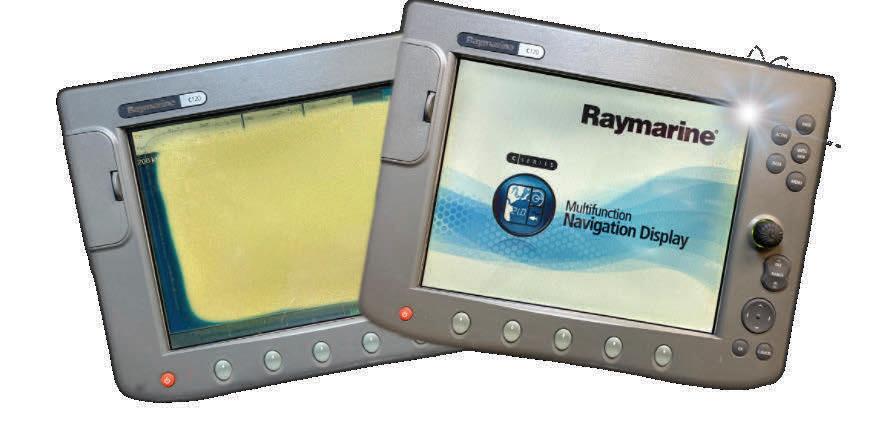
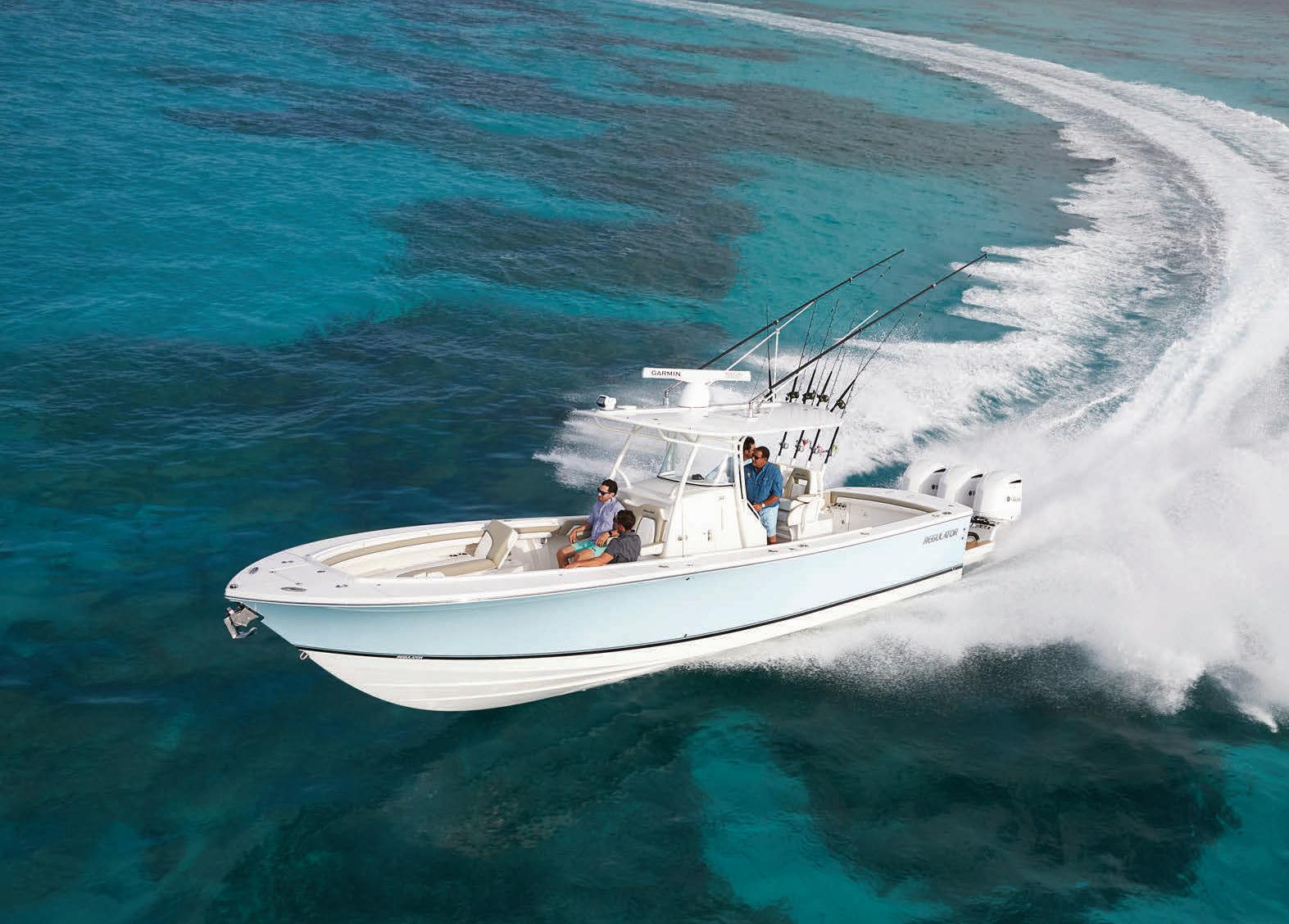
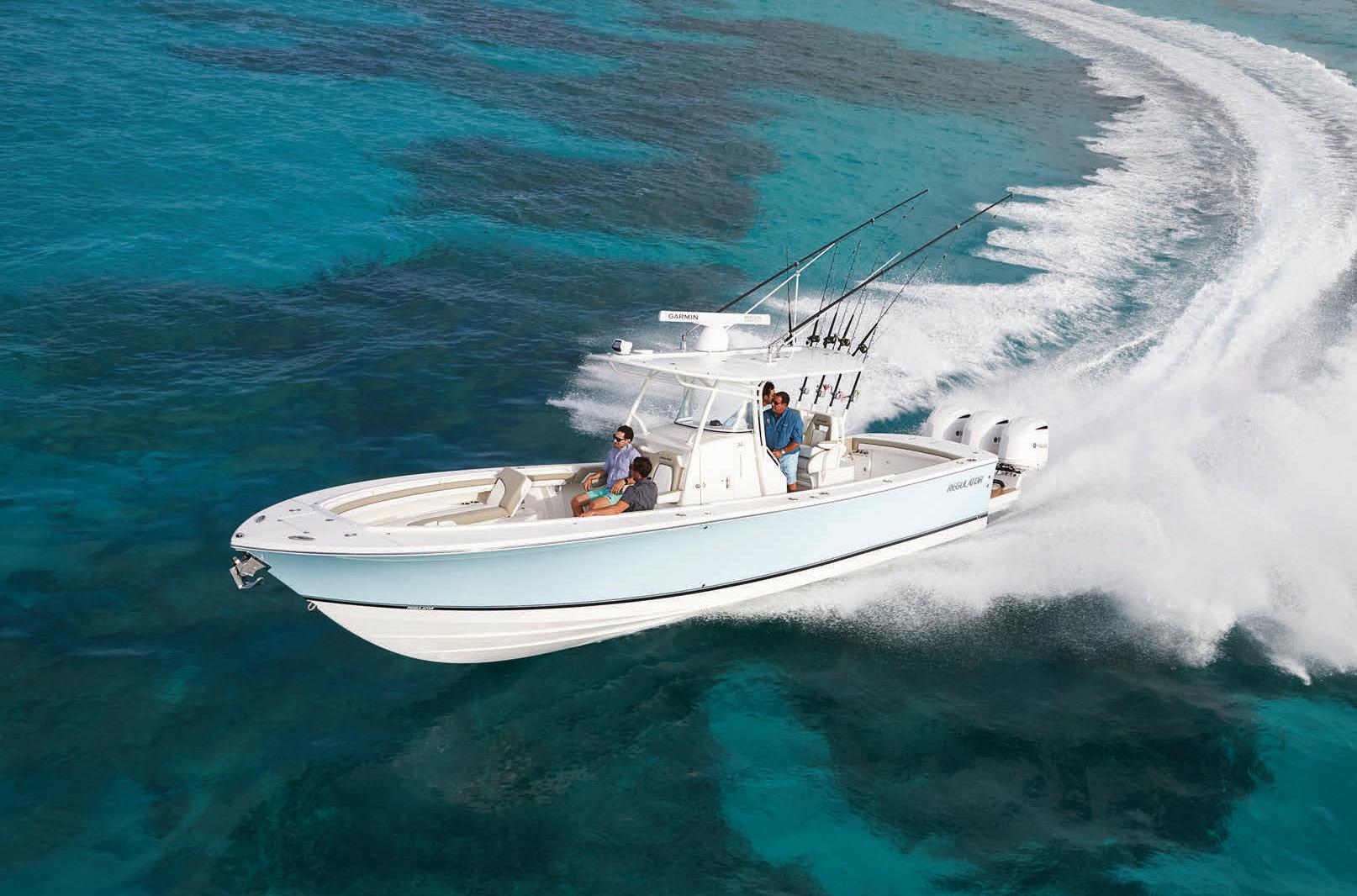
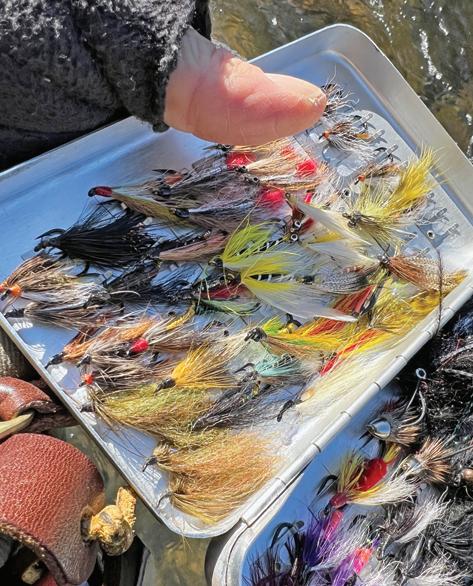
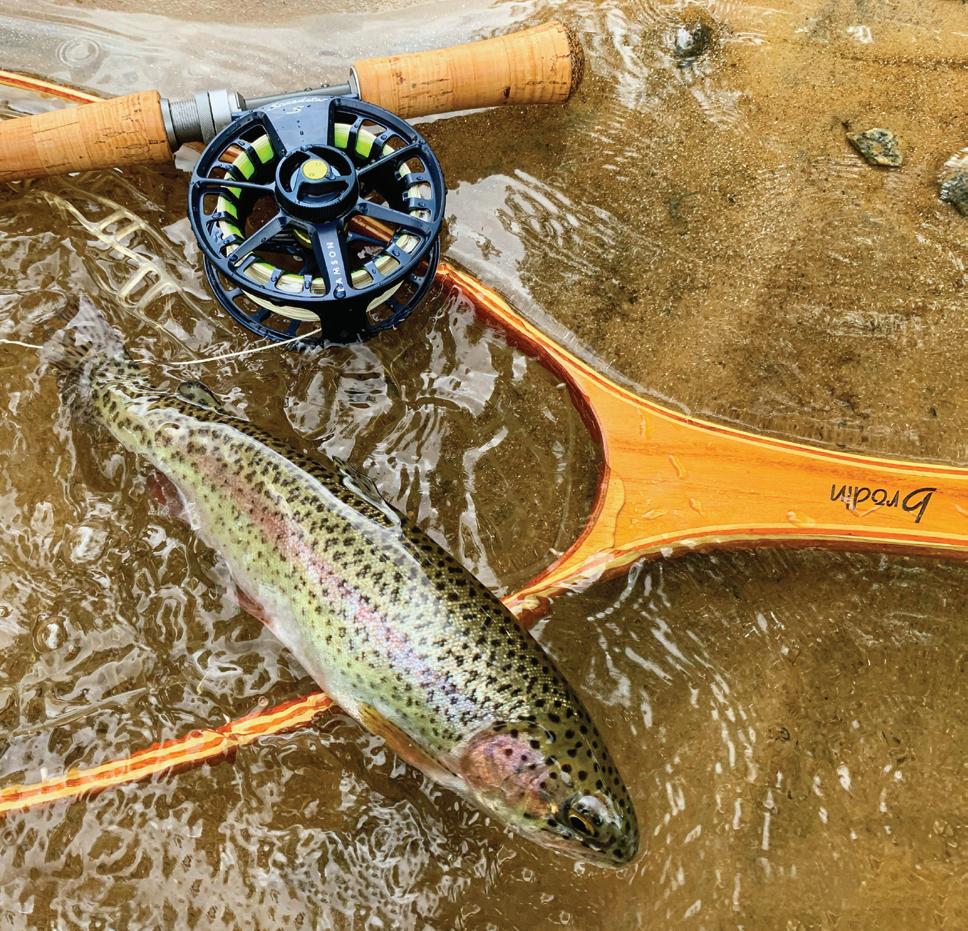
Besides being loads of fun to sh and cast, a spey rod is designed to launch ies into the next county with little or no back-cast room available. Most troutsized spey rods are less than 12 feet long, with longer rods up to 16 feet reserved for big steelhead or salmon. A 2-weight spey rod is similar to casting a 4- or 5-weight single-hand y rod. A 3-weight spey rod can handle ies in sizes that a 5- or 6-weight single-hand can cast, and so on.
Here’s the main advantage of two-handed gear: Easy casts of 70 or more
















feet can be launched from positions that are impossible with a single-hand y rod. Right now, the wheels in your head should be turning about places on your home river you have always wanted to run a y through but couldn’t reach.
Fishing is done down and across current to carefully swing ies through likely runs or holes, and the angler waits for the electric jolt of a trout or bass. Flies imitating bait sh, emerging insects, and even brightly colored Atlantic salmon or steelhead ies in smaller sizes are readily taken by sh. A well-tied y sweeping in front of a predator can draw a hunger reaction or a re ex strike in almost any condition.
Casting and shing micro spey gear is extremely fun and e ective. I hope you will join the trout spey revolution!


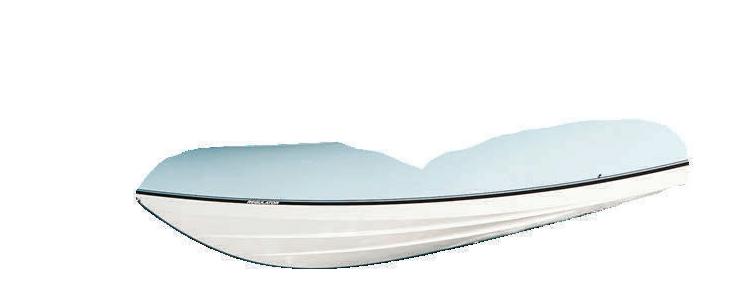

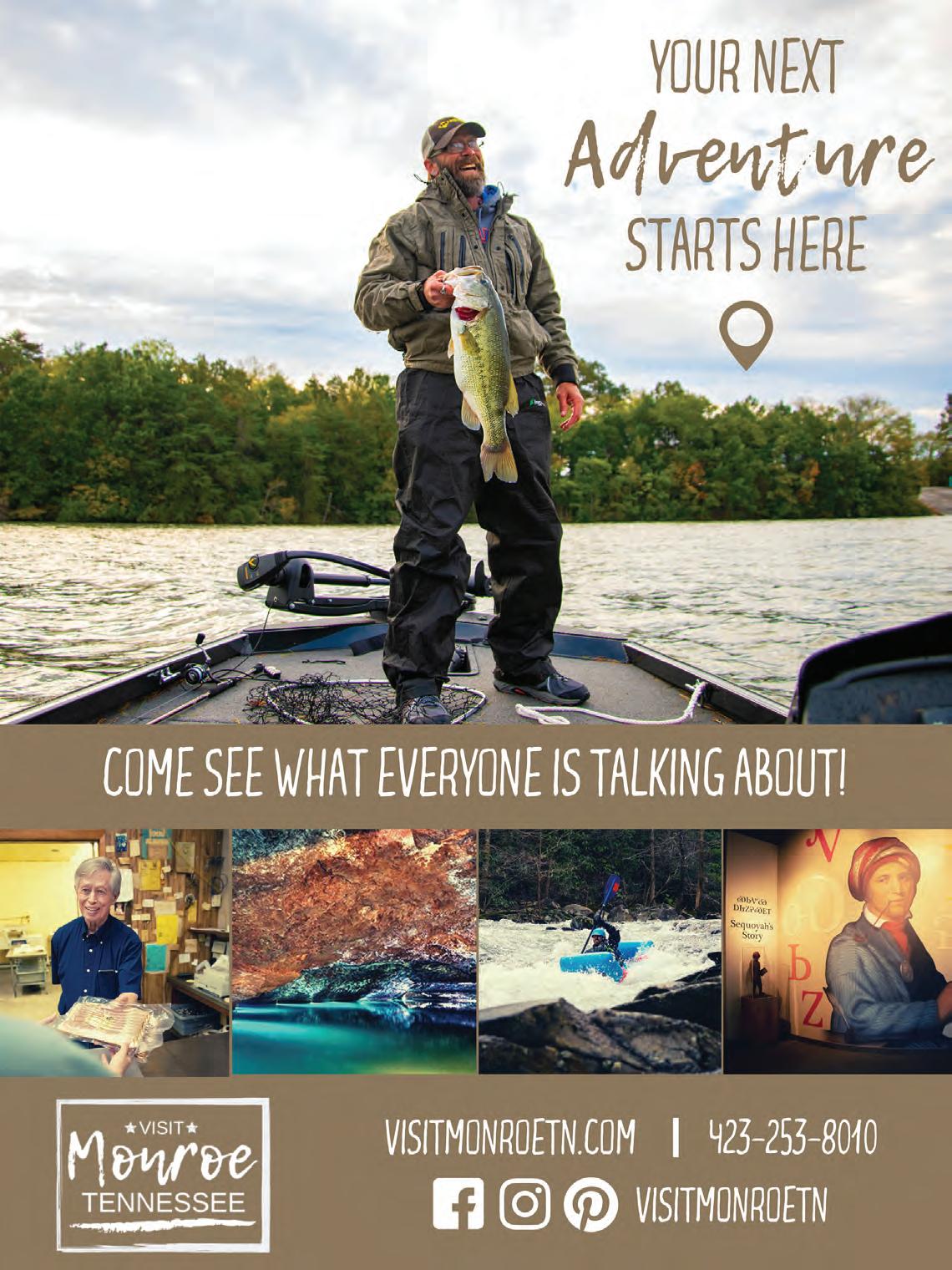
Owner StriperFun Guide Service, Tennessee and Kentucky Walleye, Bass, Crappie, Trout and Muskie Charters, Superbaittanks.com, Captain Jim Marine Electronics and much more…… DATE OF REPORT: January 2023

Greetings to my readers! I hope that the world finds you and your family doing well!
The late winter early spring striper fishing on Lake Cumberland (southern KY) is terrific, with limits of nice 10-to-15-pound Stripers caught on many days along with the occasional 20-pounder as well! We troll live bait on planer boards from the surface to 30 feet deep, concentrating on main creek channel points off the main lake. We also cast Captain Jim “Striper Magic” lures and troll “Captain Jim Special” Umbrella rigs! With multiple full-time guides, StriperFun offers day trips on Lake Cumberland year-round (weather permitting).
The Striper – Hybrid fishing on Cherokee Lake is very popular with
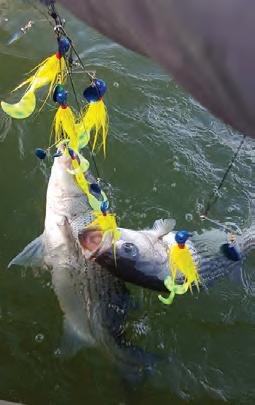
our clients. During the winter months, we troll “Captain Jim Special” Umbrella rigs! Beginning in April, we troll live bait on planer boards 10 to 30 feet deep and also downline on suspended schools of fish, concentrating on main creek channel points. The Striper and Hybrid fishing is simply off the chart! 20 and 30 fish days are frequent (TN allows catch and release)! With four full time guides, StriperFun offers day trips on Cherokee Lake yearround (weather permitting).
We Muskie fish year around on Dale Hollow, trolling antique Muskie baits! There are “huge” Muskie in Dale Hollow! For Bass during the winter and early spring, our live bait specialist floats live Shad on light lines on cliff shelves with great success! For Walleye, we begin each year Walleye fishing on Dale Hollow-fishing at night under hydro glow lights (a great product we sell!) on lake points with drop offs and grass bed edges. Our techniques include jigging, live bait, and casting a variety of lures – blade baits and
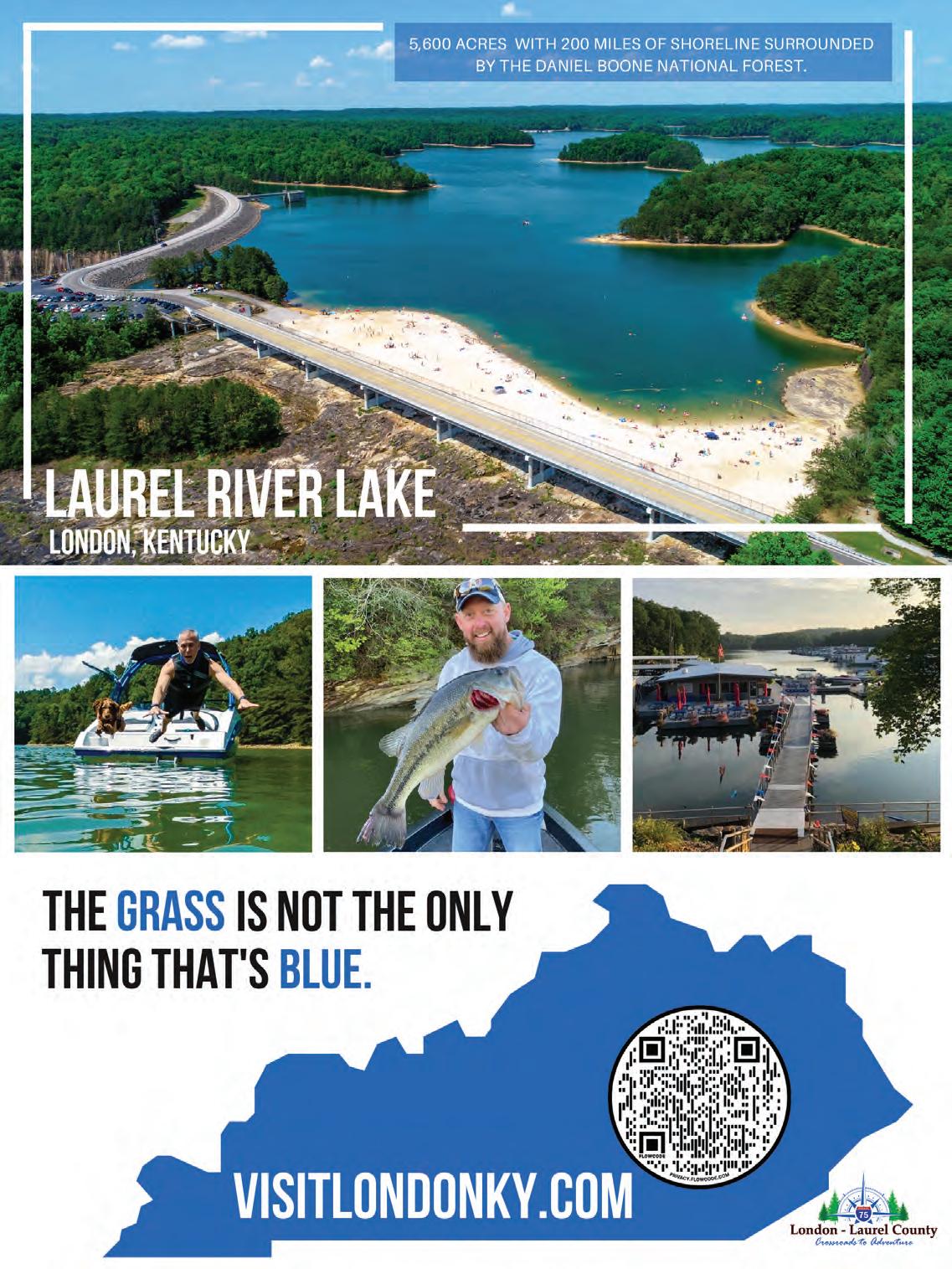
hile out on my first fishing trip of the year, my mind wondered as I watched my streamer making its erratic path through the current. I began following a train of thought that took me down a path more direct than that of my fly, but still permitting me to maintain focus on any trout that might slam my olive wooly-booger. What rose to the surface were my memories of the late, great, legendary master fly-caster Lefty Kreh.
Using my then recent marriage as a time reference, we were living in an apartment in what I believe was 1988 when the Fly Fishing Conclave was held in nearby Gatlinburg. Having been fly fishing about ten years and being in my early twenties, I thought, as do most at that age, that I knew pretty much everything I needed to know about the sport… LOL!!! In my defense, back then there was no Internet and very little information about trout fishing except what was learned through questionable rumors and found in magazines that related mostly to distant waters. So, the fly fishing event piqued my interest.
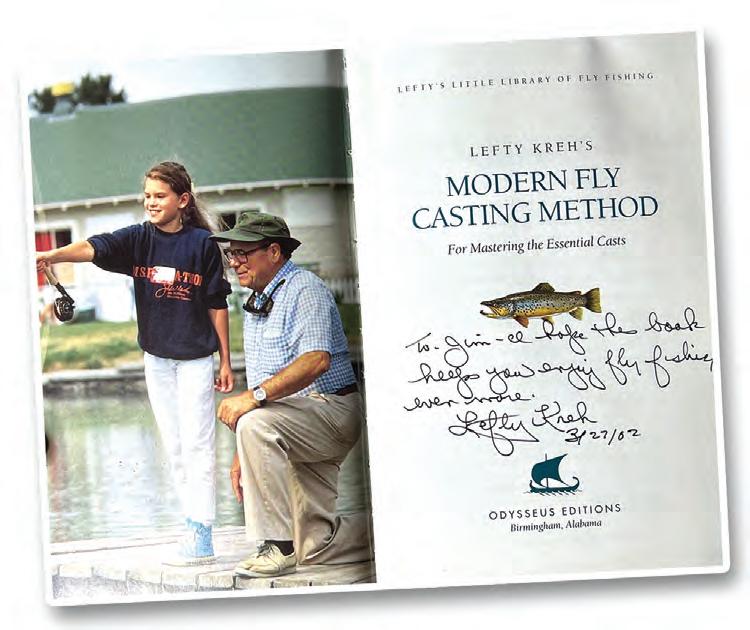
I pulled into the Glenstone Lodge, parking my wife’s Mercury Capri around the back at the far right corner of the parking lot. Noticing a stretch of tarp about four feet wide and one hundred feet long laid out in the parking lot, I parked about 3 spaces beyond one end of it. I remember reading that a “casting demonstration” was to be held. As an “experienced,” high-sticking nymph fly

fisherman in the small streams of the Great Smoky Mountains National Park, I rarely had to cast over twenty feet and I never thought I would need to. It was truly a small world for me. So, as I left my wife’s car behind, I had no doubt it was safe from whatever was to come. Having attended a seminar or two that morning, I followed a few guys out back where there was a crowd lined up making me wonder if the Rolling Stones were in town! People were standing shoulder to shoulder on each side of the tarp, one row facing the other for the entire length. To cheers, out walked this older gentleman, a bit chubby, with a smile on his face. He was a funny guy who laughed and told jokes as he began stripping out fly line. As a young fly fisherman, I was told two things about fly line. First, NEVER allow it to touch the water as it would surely scare the wild trout, and two, the main purpose of fly line was to take up space on the reel. So, needless to say, I was a bit puzzled as I watched this guy strip out all ninety feet of his fly line! In a matter of perhaps two back-casts, he was laying his leader across my wife’s car from the far end of the tarp where he stood! As if that wasn’t enough, he took the rod apart and repeated the cast using only the last segment of the fly rod!! Watching Lefty about sixty feet to my left, my chin lying on the asphalt at my feet in shock, he flips the line straight up in the air and calls out, “Guy on the right in the red hat.” I looked at the guy standing ten feet to my right. Lefty, with little motion, sends a perfect cast down the middle of the tarp with the last three feet of his line, laying gently across the guy’s right shoulder!!! To this “experienced” fly fisherman, what I had just witnessed was more shocking than if Elvis had handed me my Big Mac in the drive thru at the McDonald’s in Pigeon Forge!
That was my first experience of Lefty Kreh. The following years blessed me with more exhibitions of his amazing skills, and to say he made a HUGE impact on me is a true understatement. Ten years later, I used his book to teach myself how to cast greater distances, sans the shoulder loop, to prepare for my first saltwater trip to chase bonefish. To
this day, I occasionally refer back to that little book.
My last visit with Lefty was when he made an appearance at the Little River Outfitters in Townsend, Tennessee. After his casting demo, we walked inside. I walked out to my car to get my copy of his book for him to autograph. Upon my return, he was commenting how he had seen his wife very little recently due to his travels. Like mine, his wife never begrudged him his time away. She had a special understanding of his value and service to the fly fishing world. As I approached him with my book, he graciously autographed it as I thanked him for his help. We chatted for probably 10 minutes when, ever the instructor, he nodded his head toward the back door, “Let’s go out back and I will help you with your cast.”
To be honest, I was a little nervous about having a one on one with Lefty. I did not feel worthy of his time and wanted to just get to know the legend on a personal level. So I answered, “Lefty, weren’t you just saying you haven’t seen your wife much lately? If you start working on my cast, you’ll never get to see her again!”
With that, Lefty flashed that big smile of his and we went on talking fly fishing. Whoa...was that a nice brown that just flashed at my streamer?!
Jim Parks, a native of Newport, Tennessee, has spent forty-five years fly-fishing in the Great Smoky Mountains National Park, which he considers his home waters. For autographed copies of his book “Tails of the Smokies” contact him on Instagram at TailsOfTheSmokies. Jim currently resides in Kodak, Tennessee, with Trena, his wife and best friend of thirty-five years.


It’s that time of year on the water when it is bitterly cold and the temperature barely gets out of the 40s but, despite a chilly boat ride to your favorite location on the lake, the crappie bite can heat things up in a hurry.
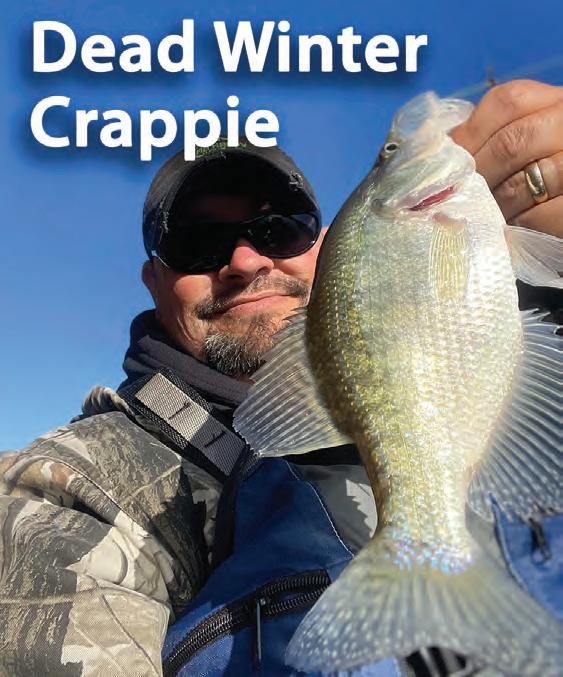
As the winter water temperatures get steady, the crappie move, following the baitfish into shallower waters of the coves, points and flats on the lake. It’s a perfect time to take advantage of those schooling, suspended crappie.
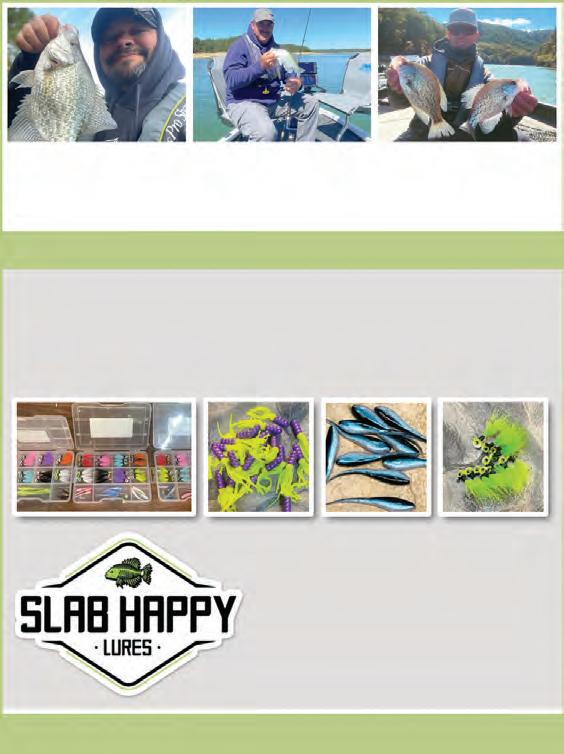
I have said it before and I will repeat myself by saying that the most common method used by the anglers on the lakes of Cherokee and Douglas here in East Tennessee is the hair jig (tipped with a minnow) and float method. One thing I need to mention also is that if you are fishing these areas and the bite seems to shut down, try downsizing your bait to a smaller profile bait and like my father told me time and time again, “slow down on your presentation”. Be sure to remember though, the key to locating these sometimes-finicky crappie is again, to follow the baitfish. This can be tricky to do as the baitfish will move into an area, bring the crappie in, and then move out again taking the crappie with them. Sometimes, all you need to do is locate a pile of 15-20 boats in one area to find schools of crappie (lol). It’s no secret to anyone that the word gets around pretty quickly regarding when and where crappie are being caught in certain areas here on Cherokee and Douglas Lakes.

If crowds annoy you as they do me, I have a solution for that. Being an Angler that prefers to feel that “thump”, I mainly continue using the tight-line casting and vertical jigging methods on brush, laydowns, steep banks or rock piles. Seems these dead winter slabs can be anywhere. For myself, if I am looking to have the best chance at a limit of fish, I will fish these areas in addition to the crowds. The advantage that I’ve found by doing this is that I am more apt to catch
By Perry Hensley
Winter is a great time to trout scout or find new sections of streams to fish before the warm days of spring arrive. Not having to deal with vegetation that covers your feet just enough to obscure your view of rattlesnakes, copper heads, and my all-time favorite-yellow jackets,
is a huge plus! Better weed-free views of the creek can help you find new ways to get to the creek without cliff diving. The stifling humidity and heat of summer here in the Appalachians is not present and this can enable you to cover more ground and water without a heat stroke. There are literally thousands of miles of trout streams here in the South that can be accessed with a little shoe leather and this month is a great time to get out and find them. Areas that are less accessible can be more easily checked out to see if a return trip is worth it.
The cold ultra-clear water can also help you find big fish in those deep holes you normally can’t get a good look at. Less pressure at this time of year makes it more likely that old brown trout might be more out in the open instead of tucked up under a big flat rock in six feet of water. I find a lot of big fish surprises in small streams right now. Larger trout have figured out how to evade
and stay out of sight of anglers or predators, but winter can make them let their guard down a little bit. Stalking a pool is much like big game hunting and can be just as rewarding.
Carrying a small pair of binoculars is also beneficial on waters that require an upthe-hill view of the stream features and they can also help you distinguish better between a twenty-inch brown and a twenty-inch river sucker! Trails in the Smoky Mountains National Park follow the creeks for miles upstream and give you great views of the stream from an elevated position. The same can be said about the streams in the Chattahoochee National Forest in Georgia. When a pool inhabited by a larger fish, or a section of stream that begs for a visit during the dry fly season is found, be sure to mark it on a map. Mental notes have a way of slipping away from our old brains but an x on the map can always be found.
Give David Hulsey a call at (770) 639-4001 to book a class or a guided trout trip. See his website at www.hulseyflyfishing.com.
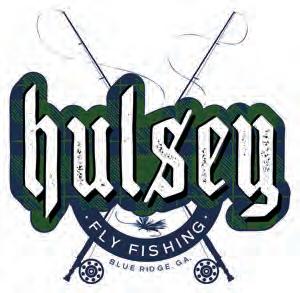

CAPTAIN JIM FISHING continued from page 2
jigging spoons. You will want to anchor up and be in place at least an hour before sunset. It is best to spend time during daylight hours “scouting” these lake points, grass beds or drop offs so you are not disoriented at night.
It is great to be alive and be a “free” American! I look forward to seeing all of you this year on the water. Always remember to stop and shake the hand of a person in uniform or wearing garb that shows they are a veteran! Their service is why you speak English, can vote and can enjoy the freedoms you do!
Until next time, blue skies and tight lines!
With full USCG and State licensing and insurance, all guides who take Captain Jim’s clients (15 guides on 14 waterways) can take you on a safe, fun, and unforgettable fishing adventure! Check out all of our fishing services as well as our exclusive “online” store at www. striperfun.com or call 931-403-2501 to make reservations today.
We are a month into 2023 and all I can say is “monster stripers”. That’s right! We are literally on these North Georgia and Western North Carolina lakes every single day and we do very well catching tons of big stripers. However, just recently we lucked up and scored a 49-inch, 51-pound striper. The young boy who goes by Wells never knew what was on the other end of that line. All he knew is that it was BIG. After about a 15-minute fight and an almost bent-in-half landing net, Wells scores the biggest catch of his life in fresh water. This is exactly why we enjoy doing this. We have some monster stripers in our area and it’s always a blast watching our clients reel them in. Going forward into February, we are in the middle of trophy striper season. This is a perfect time of year for you to have that chance to score your 51-pounder. We’ve been slaying the stripers here lately and fortunately for you, we can help you score those monster Western NC stripers. Lake Hiwassee is Murphy NC’s hidden gem for catching some awesome stripers. As this area’s #1 and only full-time striper guide service, we are here to help put you on some hard-fighting fish. Guaranteed! Check us out on Facebook and you’ll see!
Currently, water temperatures on Lake Hiwassee are in the low 50’s and water levels are around 56 feet below full pool. Water clarity is moderately clear.
Striper fishing has been crazy excellent recently! We’ve been catching a lot of nice fish in the 20 to 40-pound range. These fish are shallow and pounding bait up on the banks and shallow flats in the backs of creeks. Pulling planer boards and free lines early in the morning has been working great. Huge gizzard shad and blueback herring is always the bait of choice this time of year. It’s so stinking awesome to see a huge 30 pounder explode on a bait at the end of a planer board. It will definitely have you hooked on striper fishing once you experience this thrill. Back on track now, occasionally we’ll also pull small trout as well. Our trophy striper season has been in full swing and these techniques will continue for the next few months.
Smallmouth and spotted bass have been off the hook out here lately. This beautiful mountain lake never ceases to fail me (knock on wood). We’ve been catching some large quantities of smallmouth and spots. These fish have been schooled up on shallow flats and off rocky points around the lake. Down lining live bluebacks and ultra-lite tackle have been the best technique for loading the boat with these great smallmouths.
February is a great month for catching a lot of huge trophy stripers on this Western North Carolina lake. Give Big Ol’ Fish Guiding Service a call and let the area’s, #1-rated guide service put you on some of Lake Hiwassee’s best trophy stripers during the fishing trip of a lifetime. We are Murphy, NC’s and Blairsville Georgia’s premier full-time guide service, specializing in striped and hybrid bass. We also serve Lakes Nottely (in North Georgia), Chatuge , and Lake Blue Ridge in Blue Ridge, GA. So, come fish with the pros for the opportunity to be featured in Angler Magazine, and let us help you get your fish on!

Shane Goebel owns Big Ol’ Fish Guiding Service and is a member of The Angler Magazine Fishing Team. See the website at www. bigolfish.com or call (828) 361-2021

a mixed bag of black and white crappie instead of just the white slabs, therefore increasing my chances on catching a limit of fish. This also eliminates me wasting too much time in a dead area.
In closing, let me say that these tips and techniques are not the only methods that produce, but based on my own experiences, they continue to produce for me throughout the cold winter months, year after year. The biggest thing to take away from this article is first, to get out there and make some memories with those you love and the second is to keep an open mind and try new things when the same old-same old, isn’t working great. I know, in my case, it has made me a more productive and versatile angler. Tight Lines! Perry Hensley
2023 is the “Year of the Trail” in North Carolina. North Carolina has partnered with dozens of diverse organizations, agencies, and supporters advocating for increased state investment in all types of trails statewide. Year of the Trail activities can include a walk, hike, paddle, bike or horseback ride in the state forests, national forests, beaches, greenways, estuaries, etc., where the above activities are allowed. You’ll want to check the rules and regulations of each trail before heading out. For example: The Great Smoky Mountain National Park does not allow dogs. Other trails may require your pet to be on a leash at all times. Not all trails allow horses or camping.

So you say, “This is a fishing magazine. What’s this got to do with fishing?” Great question. In my style of fly fishing, I strive for solitude, whether in a tent next to a back country brook trout stream or on a coastal sand flat targeting tailing redfish. I’m always looking for those special places that have little to no human footprints. Typically, the only way to gain access to these hidden places is through hiking, biking, or paddle trails. Today, there are so many tools available to us with technology that finding a trail is not that difficult. Via your smartphone, you can purchase Apps like Gaia, Avenza, All Trails or onX, to name a few, all of which have their own attributes. You can also purchase maps from National Geographic or Gazetteer from outdoor stores for specific regions you wish to visit. The National Forest Service and many states offer free Apps or maps that identify trails. Although they may not be as detailed, they provide a general understanding of the landscape features.
I’m often asked how my obsession with fly fishing began. Most assume a family member or friend must have introduced me to the art. I’ve recently reflected back on this question. As a Baby Boomer kid, I remember the days before the internet, when my brother and I would


hike or bike our single speed banana seat bicycles down the railroad tracks to local ponds or several miles to the Oak Orchard Creek to fish. We used rods that were missing guides or the tips were broken off. Every bait or lure imaginable would be carried in one of Dad’s old tin toolboxes–the one missing the carry handle that creaked at the hinges when opening the lid. Although I have those great memories, I don’t think that hooked me to flyfishing. Was I influenced by watching “The Wild World of Sports” and romancing the idea of emulating Flip Pallot and his adventures as he narrated Walker Cay Chronicles? Or could it have been the energizing fast paced action of Jose Wejebe the star of The Spanish Fly and his persistent determination to get the fish to the boat when the fly line was wrapped around a dock pylon? Then it finally came to me; I really didn’t start fishing with a fly rod until my late 30’s when our kids were older and my wife and I started traveling and hiking all over this beautiful country, an appreciation of the tranquility and magic around water emerging inside me. I mentioned to her that I was considering taking up fly fishing. That Christmas, she surprised me with a white Shakespere, two-piece, 7 weight fiberglass fly rod that was recommended by the store clerk at the local sporting goods shop. I’m not sure how many pounds it weighed, with the butt section being the size of a broom handle, but I had fun with it for several months. I didn’t realize then that the weight and the flex of a rod was important–or how the correct accessories made such a difference in the soft presentation of a bug. It wasn’t long before I upgraded to more sophisticated equipment like tapered leaders, Dacron backing, waders and boots.
Since those early years, I fished or hiked portions of 26 states- from the Everglades in Florida to Crater Lake in Oregon, and Acadia National Park in Maine to the gulf coast in Texas. I learned that each state has its
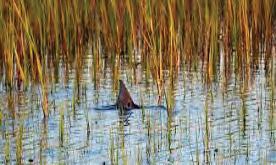

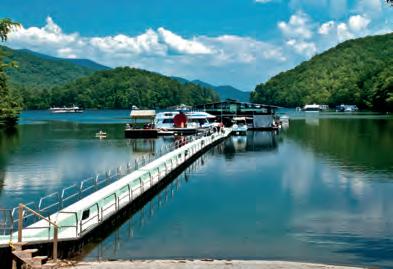





own distinct qualities, whether it’s snow covered mountain peaks, sand beaches, or hot deserts that include hiking trails and fishable waters. That’s what got me started in casting a fly rod. It wasn’t specifically about fly fishing in the beginning, but more the incredibly beautiful places we hiked to that guided me to fly fishing opportunities. It also can be argued that flyfishing provided the reason to travel to specific destinations.
Why not add to your hiking adventures, additional memories of catching a 10” wild Brook Trout in each state possible, releasing a 100 pound Tarpon on a Toad fly you tied, or hiking several miles to an Alpine Lake next to a glacier to catch a 20” cutthroat? Some people dream of climbing every high peak east of the Mississippi and some enjoy bird watching or hunting for wild mushrooms. For me, it’s fly fishing into the remotest parts of the country “to boldly go where no man has gone before.” All these activities include using trails.
Some of the best backcountry fishing locations I’ve discovered
slip into the good life slip into the good life
were found by researching the trail systems and cross referencing the trails with streams, lakes, ponds, or coastal flats that looked promising. I’ll give you a couple of North Carolina examples:
1. I was researching ncpaws.org to identify wild trout waters in western NC and found Stone Mountain State Park. It’s a beautiful park that includes some great hiking trails. Some of these trails are extremely strenuous and some are easy. A little side note, you can observe people mountain climbing on the face of Stone Mountain, which if you’ve never seen is incredible to watch. Going through the heart of the Park is Stone Mountain Creek, a Delayed Harvest stocked stream that provides the opportunity to catch Rainbow, Brown, or Brook trout just a short walk from the gravel road. Here is the best part: there are many feeder streams that provide opportunities for wild Rainbow and Browns. What do you think follows these streams to where they originate? You guessed it-maintained hiking trails, which in many cases include backcountry campsites. If you’re just exploring and don’t want to carry all your backpacking and fly fishing gear, consider a day trip wet-wading with a 6.5’ or Tenkara rod, a spool of 5X tippet, and a pocket sized fly box with an assortment of size 14-20 dry flies. I think you’ll be surprised at how much fun you’ll have even if you don’t fish.
2. When looking for places to backpack on the eastern portion of the “Mountain to Sea Trail” in NC, I found the Croatan National Forest a few miles west of Beaufort, NC on Route 101. I learned that Beaufort is a quaint little coastal town offering incredible summer saltwater paddling and fly fishing opportunities. The water is easily accessible by canoes or kayaks. There are two state operated boat launches at each end of town, in addition to fishing piers for those that don’t want to get wet. When heading east into Beaufort on Route 70 over the high rise bridge, look down and left or west at the marsh grass. This is a great place to cast a 8 or 9 weight fly rod to tailing Red Fish when the tide is rising or falling. You’ll want a 20 pound leader with a dark colored weighted Clouser Minnow tied with some gold flash. Don’t worry about setting the hook, the Redfish will take care of that. Just hold on and enjoy the workout at this spot, or the many other tidal flats around the Beaufort and Morehead area. You just have to get off the couch and go exploring!
3. Many of our county or local, town Greenways provide access to freshwater fishing opportunities that are often not considered or overlooked. As you paddle or walk along the banks and see mud clouds in the water, it’s likely created by carp that you spooked. If you’ve never fished for carp with a 7 weight fly rod, you don’t know what you’re missing. A successful, stealthy approach and soft presentation of a size 16 Scud or Wooly Bugger, will often provide you the opportunity to see what your backing looks like. You’ll want to inspect all knots in your fly line as they will be tested. During the high heat of summer, when the trout streams are too warm to fish, is the perfect time to pursue carp with a fly.
I challenge you to hit the trails this year and visit these wild places to create your own memories. The complete list of mental and physical benefits is too long to list but it’s proven that anxiety and stress can be reduced with exercise. If you are considering adding fly fishing to your hiking adventures, shorten the learning curve and find a mentor, or hire a guide to learn the fundamentals of casting a fly rod and reading water. Then try going to a local farm pond and catching sunfish or crappie on a 2 or 3 weight before advancing to moving water and bigger fish. Taking a kid fishing adds to the excitement and teaches the fundamentals of “Leave No Trace” while in the wild that should be taught to everyone.
Some personal thoughts about “Leave No Trace” before using the North Carolina Trail system:

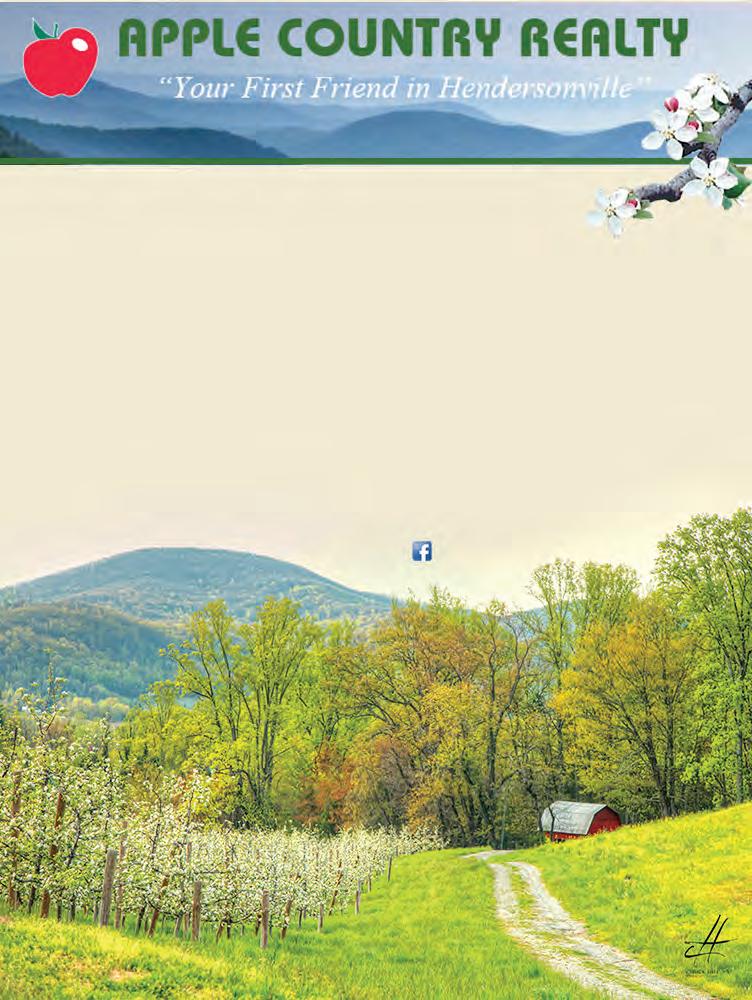
•If you’re the kind of person that rolls the window down in their
vehicle to throw bottles, cans or trash out, please stay off our trails.
•If you’re the kind of person that lets their trash blow around when the wind tips over the garbage can and you don’t think it’s your responsibility to clean it up, please stay off our trails.
•If you’re paddling in the water and an item blows off your vessel and you keep going and don’t turn around to pick it up, please stay off our water trails.
•If you don’t think you should dig a hole 8” deep to bury your human waste, then stay off our trails.
Below are a couple reference links for hiking in North Carolina: www.greattrailsnc.com www.visitnc.com/story/69Eb/celebrate-year-of-the-trail-in-north-carolina www.ncdcr.gov/experiences/tripstravel-ideas/north-carolina-trails-guide
Brian Laney is an avid “Blue Line” fly fishing enthusiast. He’s an expert in utilizing canoe and backpack to reach the most remote backcountry in our wildest places. He resides in Raleigh, NC with his wife. He can be reached via email at brian.laney8@gmail.com
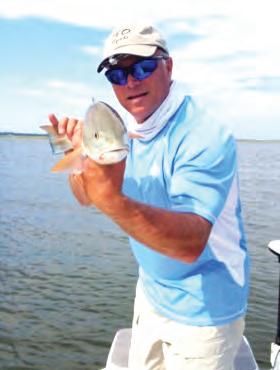
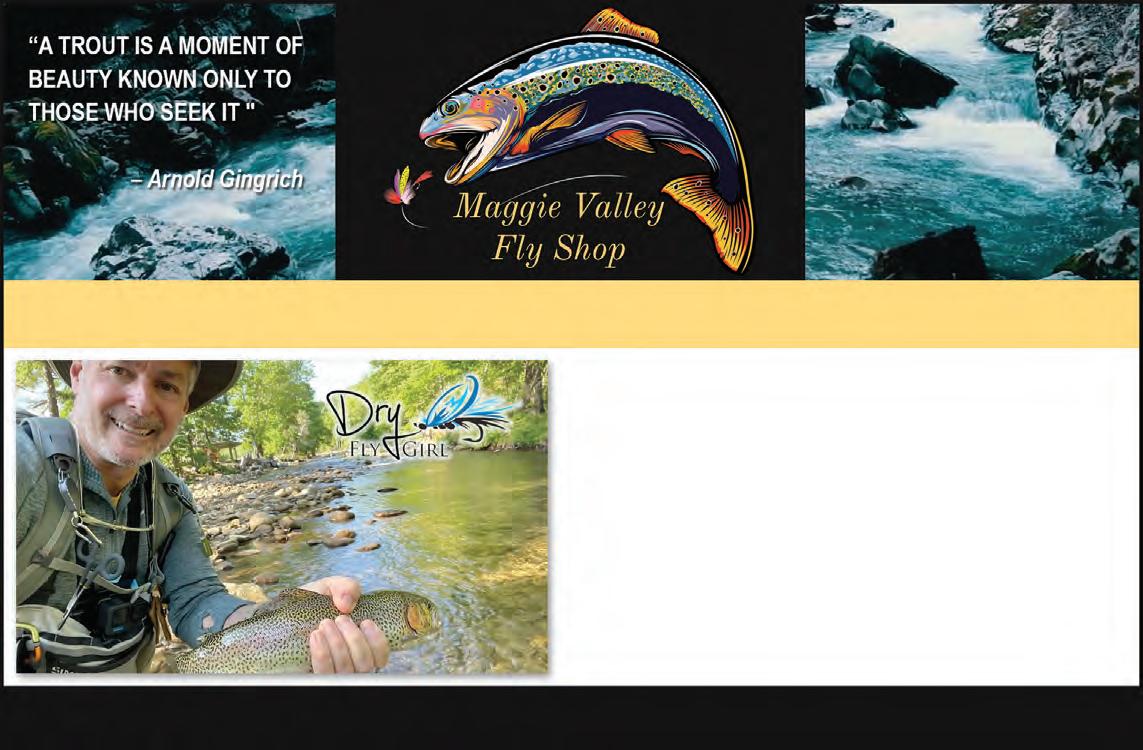 By Capt. James McManus
By Capt. James McManus
Ilove it! That first day, when the winds calm, the sun’s warm, and there are no distractions to keep me off the lake. February can be an exciting time to be on the water, with fish coming out of winter doldrums. Spawning season is just around the corner and fish are typically in as good a shape, real fatties, as they will be all year. They are also shallow, or headed that way, which is a pretty big deal on our mountain lakes. A good cast towards the bank will put your baits from the surface down to 45 feet or so in most places. Our bass can be anywhere in that range and barring a really cold blast, shouldn’t be any deeper.
After some shad die-offs because of the cold, there won’t be as much competition for your offerings as in the fall. This can make for aggressive feeding, especially if the weather cooperates. Baits are as varied as your personal tastes but I typically stick with natural size and color with depth controlled by whether I go plug or jig. My go-to plug shallow to 20 or so feet is a Rapala jerkbait, my deeper jig combo has an eighth oz. head with a Kietech or Zoom swimbait. As crawfish start to move around, a lipped crankbait is killer at times. I like to still target points where there is a gravel clay base with a few big rocks thrown in. As our lakes start to refill, our fish move so it sometimes takes a little scouting.
My only problem this year is that I am building us a new house. Our daughter’s family is bringing their five adorable kids and moving into our old house so we will have quite the crowd on East Fork real soon. Trying to finish the house in time to take grandkids for some spring fishing, which includes lots of snacking, netting, swimming and occasionally catching, can’t wait. Remember to take time to take kids whenever possible, bundle up if you get out and be safe. ‘Til next time, Capt. James.
Capt. James McManus owns 153 Charters. Give him a call for a great day on the water at (828) 421-8125



Two nymphs under an indicator is a great way to catch trout, and this is how most beginner fly fisherman start out, but have you ever noticed how awkward it is to cast on a premade leader? I remember how frustrating it was as a kid sitting on the bank trying to save the tapered leader I just bought, only to end up cutting it to pieces. It wasn’t until later that I was taught a much simpler method that not only casted much easier, but was also much cheaper and lasted for considerably longer.
By Ethan HollifieldThe reason that premade, tapered leaders tangle when used for nymph rigs is because of their design. While normally just fine for using dry flies or dry-dropper rigs: there isn’t enough butt section to turn over the weight that is used on modern nymph rigs with indicators. To compensate for this, the leader system, I learned, was essentially all butt section that was made using maxima leader building material. The leader formula itself looks something like this:
Fly Line -> 6’ of 15lb/20lb Maxima -> tippet ring -> tippet -> nymphs
The nymphing leader I’m laying out is intended to provide a long, stiff butt section that will be best suited for a fast action 9’ 5 weight rod
(which is what most beginners start out with anyways) but can also be modified for lighter or heavier rods by simply increasing or decreasing the pound test of the leader material used. Because maxima is very stiff, with little memory, it’s able to transfer out the necessary energy required on the cast to roll out a double nymph rig very easily. I find this is best suited with a roll cast or a lobbing motion used with “high sticking” methods, fishing at relatively short distances. Another trick that will help achieve a smoother cast is to add most of the weight, whether it is a heavier fly or split shot, to the end (or the point) of the system. This will allow for the leader and flies to cast in a relatively straight line that greatly decreases the chance of tangles.
I’ve had great success teaching and guiding people with this method, and have found in the past that it is a great starting point for those looking to build their own leaders as well. These leaders will also last for a very long time, and pre making a couple to take with you while you’re on the water will save a tremendous amount of time and hassle on your next outing.
Hollifield is a member of a conservation organization called 2% For Conservation and a guide for Southern Appalachian Anglers


Hey folks, I hope everyone is well. I don’t know about you but I’m already looking forward to some warmer weather. With that being said, the fishing has been awesome so far this year; catching good numbers of bass, perch, crappie, and walleye. Now, anyone that knows me knows I love fish but there’s one thing I enjoy more and that’s eating fish. So, I thought for this article I’d share some tips that’ll help you enjoy eating your catch.

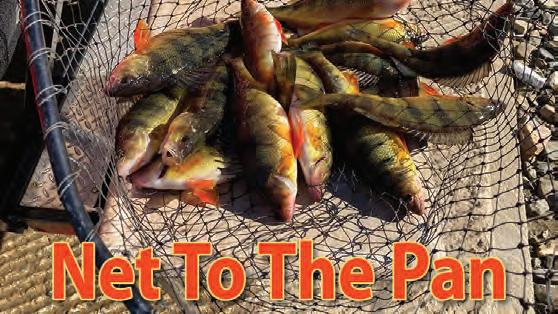
Now, on about every trip someone invariably asks what’s my favorite fish to eat. Without a doubt, my favorite species is our wild Brooke trout. Nothing tastes better than a fresh caught Brooke trout, rolled in cornmeal and pan fried right on the side of the creek. Rainbow and brown are really tasty but don’t compare to Brooke trout. As far as lake fish, I really like crappie, yellow perch, walleye, blue gills, and spotted bass. We do have catfish, white bass, and striped bass in our lakes, and I do like these but tend to prepare them differently. For the white bass and striped bass, I like to cut out any red meat and I usually cut them in smaller pieces. If I’m gonna’ blacken them, I don’t do much else to the fillets If I’m gonna’ fry them, I’ll soak overnight in buttermilk, which draws out the oils and makes the fillet not taste as strong. The crappie, walleye, yellow perch, and spotted bass, I like fried. I usually just dip my filets in egg and roll them in cornmeal and pan fry or deep fry. There are numerous fish fry options you can get at the grocery store, and most are good. Some of the Cajun breading is really good, if you like it spicy. One of the best, if this is your taste, is called Uncle Bucks and comes from Bass Pro Shop’s. Just be sure to add cornmeal to it or it will be so spicy hot you can’t eat it. Same as the blackened seasoning you really need to experiment to see what fits your family’s tastes. I guess if I had to pick my favorite, it would be my own which is to put ruffles potato chips, chees-its, and saltines in a blender and make a powder out of them; then add a little cornmeal. It is really good but costly for fish batter. I was lucky and got a version of Long John Silver’s batter recipe from a friend I really like it too.
I prefer my fish fileted, with the exception of smaller trout and bluegills. Both of these tasted better cooked with the bones in and skin on. I simply scale the bluegill and dip in egg, roll in corn meal, and pan fry. Probably one of best tips I can give you is, after the fish is caught, keep them cold until you get them home. I’ve seen folks put fish in the live well in 80-degree water and by the end of the day, the meat was so soft you couldn’t hardly filet them. I keep ice on the boat for keeping my clients’ fish cold in the summer. Also, if you’re not going to eat them fresh, be sure to either vacuum seal the filets or completely cover them with water and freeze them. Fish are always better when eaten as soon as they come out of the pan but if you can’t eat them all then simply place the leftover fish in a toaster oven for a few minutes and they’re still pretty good. As good as our fish tastes, don’t keep more than you need. I’ve seen folks with fish in their freezer from 3 years back. No need to waste such a valuable resource. Well, I hope you get something from this article to help you enjoy your catch and as always, be sure to take a kid fishing!
Ronnie Parris is owner and head guide of Smoky Mountain Outdoors Unlimited-Fontana Lake Fishing Guides, headquartered in Bryson City, N.C., heart of the Great Smoky Mountains www.smounlimited.com; (828) 488-9711.
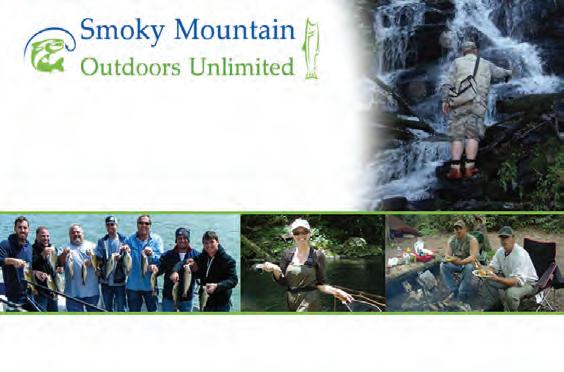
Fontana Lake Fishing Guides – Ronnie Parris, Owner & Head Guide LAKE, CREEK & RIVER FISHING • FLY FISHING • CAMPING We o er both full and half day trips with the most competitive rates available. All tackle and supplies you will need while you are on your trip is covered by our listed price. 1012 East Alarka Road, Bryson City, NC • 828-488-9711, Cell: 828-736-9471 smokymountainoutdoorsunlimited.com

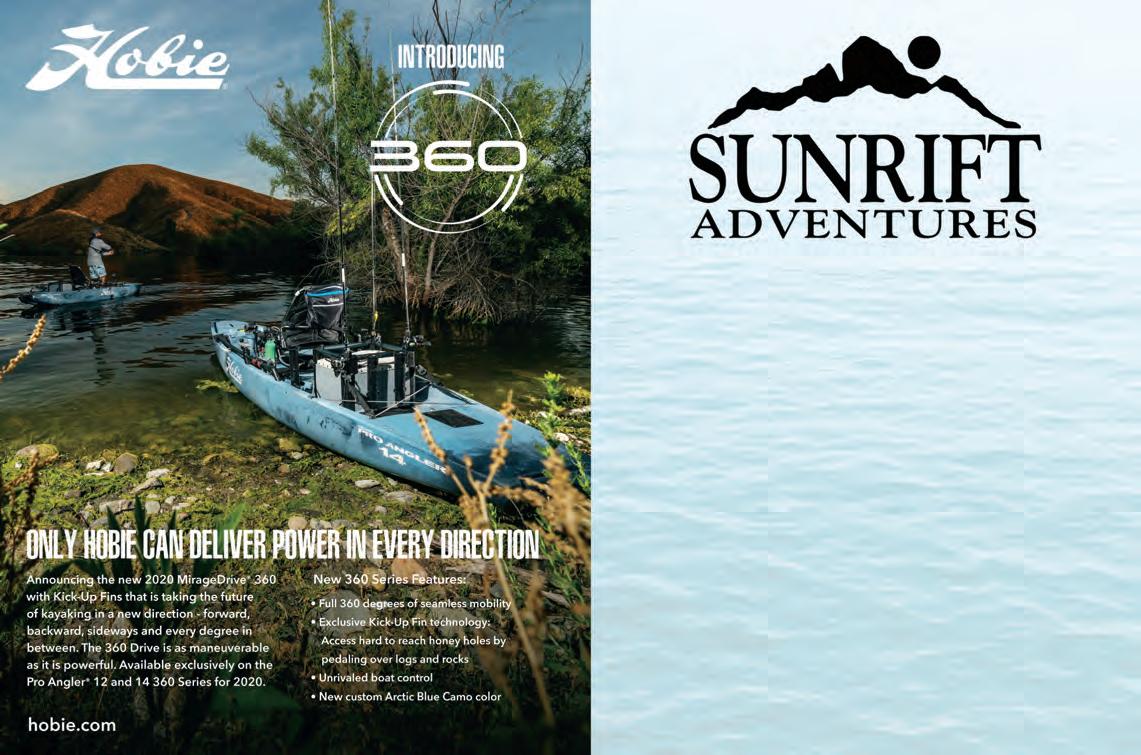 By Karl Ekberg
By Karl Ekberg
Winter fly fishing in the Southeast has been a roller coaster of events this season. Temperatures below freezing a few days, a day or two a week with heavy rains, a few spring-like-feeling days with plenty of warm sun, but no snowfall for South Carolina. For some, the no-snow is a blessing, compared to the havoc nature creates here when it snows; although some of us love the snowfall and the quiet stillness it brings streamside. We’ll have to see if Mother Nature will grace us with a little snow. February brings the same mixed bag of weather, with changing temperatures, and a wide variety of water conditions.
While temperatures hover near the freezing mark for a few nights, water temperatures will be in the low forties. The use of heavy nymph dropper rigs, with small trailer flies, will get flies down in the depths of the river quickly to find fish on the river bottoms. Small, heavy steamers will also produce fish with dead-drift and slower retrievals. Fortunately, the weather does not consistently stay below freezing for very long,
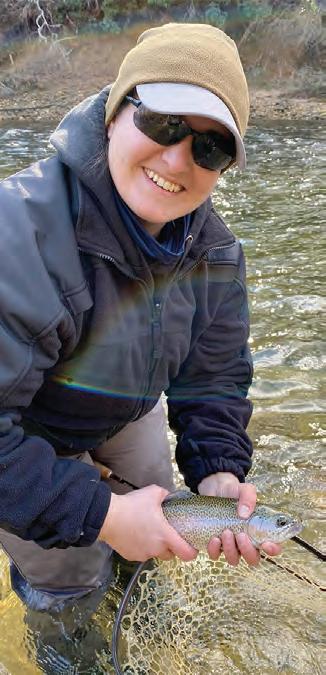
and milder days bless the riverside, along with the emergence of some hatching bugs. Although hatches can be sporadic, and trout apprehensive to rise to dry flies, there are some gorgeous short sleeve, dry fly fishing days. A good approach is to have a few dry flies, an array of emergers, numous soft-hackles, along with various nymphs. On warmer days, having a tandem nymph set up for early mornings, then transitioning higher in the water column as the sunlight warms the water to emerger patterns and soft-hackles. Dead-drifting and swinging the emergers and soft-hackles will produce good numbers of fish.
Dry fly days may be limited, but never obsolete. Longer leaders, smooth casts, and long drifts will make a productive mid-day to afternoon. Be patient, do not rush, and watch for dimples or rings on the water’s surface, and it will be time to tie on the dry fly. Watch for bugs flying off the water, and a careful capture of one of these mayflies or caddis will be very helpful in choosing


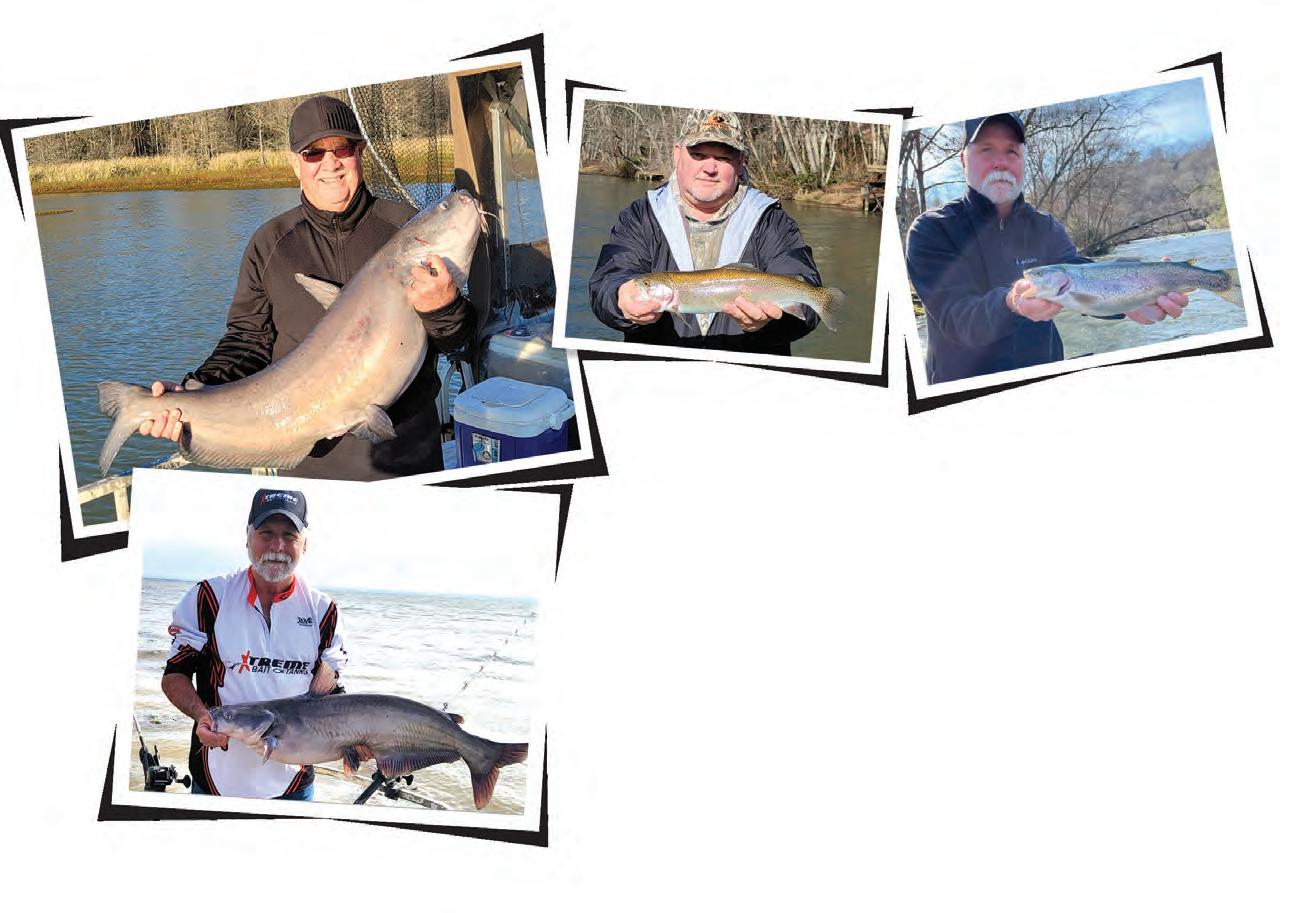
toward McCaysville a little after 4 AM. We were excited, it had been over a year since we hit the Toccoa River with my friend and guide, Joe DiPietro. As we swirled downstream after the big trout, Stacy was gaining line on it. He was trying not to horse it in for fear of losing it! Joe rowed us through the rocks and rapids following the fish until Stacy wore it out and brought it boat-side where Joe netted it. It was a nice Rainbow! We were all smiling; it’s always fun to chase down a good fish on the river and bring it to the net. We caught several more nice trout that day. This is an experience I have had the pleasure of participating in many times with several friends over the years. I have a trip booked to take my friend Matt to experience it week after next, and I can’t wait!
If you want to have a blast catching trout, then the Toccoa River flowing out of Lake Blue Ridge is a good place to go. Joe does two-man, guided drift trips from Curtis Switch Park to the Horseshoe Bend Park, and sometimes longer if you want. Joe’s drift boat is like a water bug, it has two toons and a chassis that sits atop of them. He sits in the middle seat where he rows and maneuvers you through the rocks and rapids and all the while you can fish!
If you want to fish the Toccoa River on your own, there are many people who do this every year, and wading is the favored way. If you are going to do this, please read all the warning signs. They are posted at spots along the river, and they tell you how long after the generation times the river will rise and at what distance from the Blue Ridge Dam. A quick rule of thumb about the rising river: If you are wading, mark a rock that is 1-2” out of the water, when that rock gets covered up, the river has begun to rise where you’re fishing and you should start working toward the bank. Also, if you start to smell fresh water (smells like rain), then the river is about to start rising fast. If you start to see debris coming off the bottom and the river is clouding up, the water will be rising soon. These are your warning signs to get out of the river. If
you find yourself trapped out in the river, forget about your gear, no gear is worth your life; let it go and float yourself feet down-current like you are sitting in a chair, and work your way to an eddy or bank and get out. Do not try to swim against the current, you will tire out fast or hit a rock that could injure you. The best thing to do is always wear a PFD, but you still may get caught in the river, so pay attention to the rising current.
Next week, Stacy and I are headed back to Santee where we were last month with our friend Ricky Hix. It was Ricky’s first trip to Santee with us, and we fished two days with my friend and guide, Dewayne Profitt. The last fish of day two was Ricky finding a 39-pound Blue Catfish! Not long before that, Stacy pulled in a nice 29-pound Flathead! All of us caught several good fish, 16 of them over 12 pounds, and had a great time. Fishing with friends, new and old, always makes the time on the water so much more enjoyable.
You can get more information on fishing with Joe DiPetro by calling him at 706-851-4001 or email him at FanninTrout@gmail.com. His Facebook link is Facebook.com/TroutFishingNorthGeorgia and tell him Gary sent ya’. You can get more information on fishing with Capt. Dewayne Profitt by calling him at 740-404-3900 or 803-478-6479. His website is TakinitEasyGuideService.com.

Get with some of your friends and take a fishing trip. Whether with a guide or just on your own, GO FISHING!
I’m not sure what next month’s article will be on but remember, if you have an empty seat on your boat that needs filling, shoot me an email and maybe it will be about fishing with you!
Please remember, if you are not going to eat it, don’t kill it.
“Tight Lines and Squeelin’ Reels put a Smile on my Face Every Time.” Gary Turner
You can reach Gary Turner at gary@purgeright.com.

The South Carolina Department of Natural Resources Freshwater Fisheries Section has started the process of stocking thousands of catchable-sized (8 to 11-inch) trout into the lower Saluda River near Columbia.
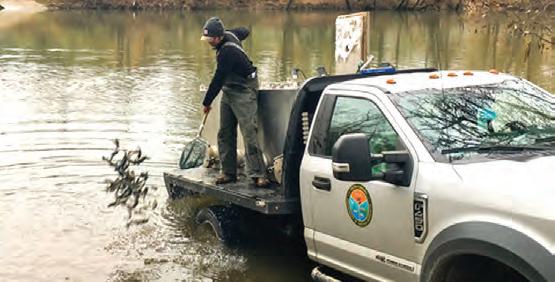
The rainbow and brown trout that are raised in and transported from the Walhalla State Fish Hatchery in Oconee County will be delivered by truck to multiple locations in the Lower Saluda River.
The cold waters released from the bottom of Lake Murray provide suitable habitat for the trout, creating a unique and popular fishery in the Midlands of South Carolina.
SCDNR stocks nearly 30,000 trout each year in the lower Saluda from December through February in what’s called a “put, grow and take” fishery that relies on stocking to maintain populations.
Trout grow rapidly after stocking and can exceed 20 inches in one to two years, which is considered trophy size for this type of fishery.
Anglers should keep in mind that the lower reach of the Saluda River, from the eastbound Interstate 20 bridge downstream to Stacey’s Ledge, is yearround catch and release fishing for all species of coldwater trout. It is unlawful to take and retain trout at any time in this section of the river.
South Carolina Department of Natural Resources, Rembert C. Dennis Building 1000 Assembly Street, Columbia, SC 29201


options for the fly to tie on. First, whether the bug is a caddis or mayfly; second, the size and shape; and third, the color of the fly. Casting and drifting to rising fish, and a sign of refusals, tie on a smaller size of the same fly. Further refusals from the trout - start swinging the emerger of the bug toward these fish, as they may not be eating the adults on the water’s surface.
February also brings the Atlanta Fly Fishing Show, and this brings a great time to see new products we will be carrying in our shop, learning great techniques and information from a great wealth of knowledge in the industry. We hope to see everyone out on the rivers, and let’s all of us remember to “leave no trace”, as we enjoy our time on the river.
Karl and Karen Ekberg are co-owners of Chattooga River Fly Shop, located at 6832-A Highlands Hwy, Mountain Rest, SC 29664. Give them a call at (864) 638-2806 and visit their website at www.chattoogariverflyshop.com.
Why would any bass fisherman in their right mind fish the cold weather? There are many reasons for choosing to do so. Did you know that the warmer the weather is, the more competition you will have. This is just one tactic to use to catch that trophy fish you always wanted. This is not for all fishermen, but for the few that take the challenge, you can invoke the spirit of Captain Ahab. This is the time of year that what bites you get, will be big bites.
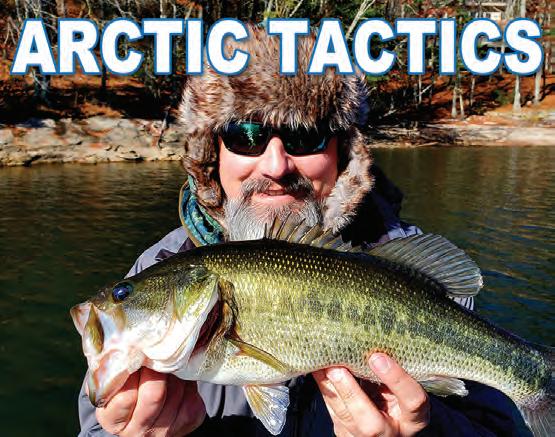
Fishing in the deepest of winter offers more rewards than you think. Large bass still have to feed to support their body mass. Small bass will stop biting as they have stored what is needed to get through cold months. If you think this is for you, you must throw away everything you think you
know about bass fishing. I believe most anglers struggle to find a starting point when it comes to winter catches. If you are looking for the starting point, then I would say think about the hottest time of the year. Now most anglers can relate to that, seeing as it is a more comfortable time to fish. Ask yourself where do they go in the summer? How do they like the bait to be presented? The answer is slow, very slow, and deep.

I will say that some of the baits will change in the winter. What you want is the “do nothing version” of what you use in the summer. Think about a jig, this is when you want to downsize. Think about a crank-bait, this is when you want the tight action version. Think about the swim bait, go big and crawl it very slow on the bottom. Everything is the same with the exception of using the opposite of the same version.
The one thing that gets a fisherman is upsizing your baits for cold water. This is usually the plan of winter, go big or go micro. The trick is to present them slow, painfully slow. You need to do your research of which baits were designed for that situation. Some cross over from hot water fishing. I will say if you can drop down on reel speed, now is the time to do so unless it is a jerk bait or a bottom contact lure.
You will want to be prepared when going out this time of year. This is the time of year you do not want to cheap-out on warm gear to wear. Do not get me wrong, it can get dangerous out there so you will want to plan for that, Make sure you are in the comfort zone but you have a plan in case it gets worse. I will say, I would recommend going out in the cold if you are an un-experienced angler, at least by yourself. Find someone with experience; chances are they have not gone themselves because they cannot find someone to go with. Some only want to go with someone out of a concern for their own safety and some go alone because they know what to plan for.
Try it out and maybe this will enable you to learn more and have fun at the same time.
Let me start by saying that I find the heavy quiet and low visual range of fog to be quite relaxing. But then again, if I’m out on the water it’s usually in a canoe without any noise except the occasional tap of my rod resting back onto the yoke across the center of my canoe, or the accidental thud of my paddle against the sidewall of my boat. I suppose, to people in a larger craft, that are used to moving much faster and require more depth to navigate, fog can be at the least, a frustration and at the most, a dire concern.

I look at ground clouds as nature’s pause button on human busyness. Thick fog, which can pop up around our region of the country this time of year, depending on stubborn fronts sneaking under the cold weather push of the Ohio Valley’s shared Canadian air, can look like large blankets of cotton, or like someone in the heaven has walloped a huge helping of cool whip on the fields and valleys where water rests or flows. Sometimes, it will come to rest along just the top halves of engulfed ridgelines.
I also suppose that people who have very important business and goals to attend to can grow rather impatient with fog. After all, when you need to get from Point A to Point B in a specific window of time – something like not being able to see more than 100 feet in front of you can kind of hinder your progress. But I think that’s the point, because everything in nature has a point. Fog forces us to slow down, to dial in our senses on our surroundings more. You could just blaze forward, recklessly, and
hope that you don’t get into any serious accidents. But your luck will run out. Better to take your time and be intentional. Connect with your environment, closely.
If you’ve read my column over the years, then you already know that I’m not just talking about being on the water, walking a ridge line, or driving down a country road. I’m talking about life in general. We all encounter a good share of fog in our lives, whether it be uncertainty in our careers, finances, health, or even relationships. It can be hard to see what lies ahead. Obstacles can spring up on you with little to no notice if you move too fast during times of fog.
Like in nature, so too is the reality in our daily lives...When you encounter thick fog, slow down. Dial in your senses to your surroundings. Listen closely for small sounds to help point you toward a shore or away from danger. Be intentional with each gentle move. The fog will pass. It always does. So lean into it as an opportunity to relax your pace. Nature always points our way to living more harmoniously, if we will just listen to its advice. Welcome the chance to slow down as needed, an occasional friend rather than waste any energy in the futility of fighting fog.
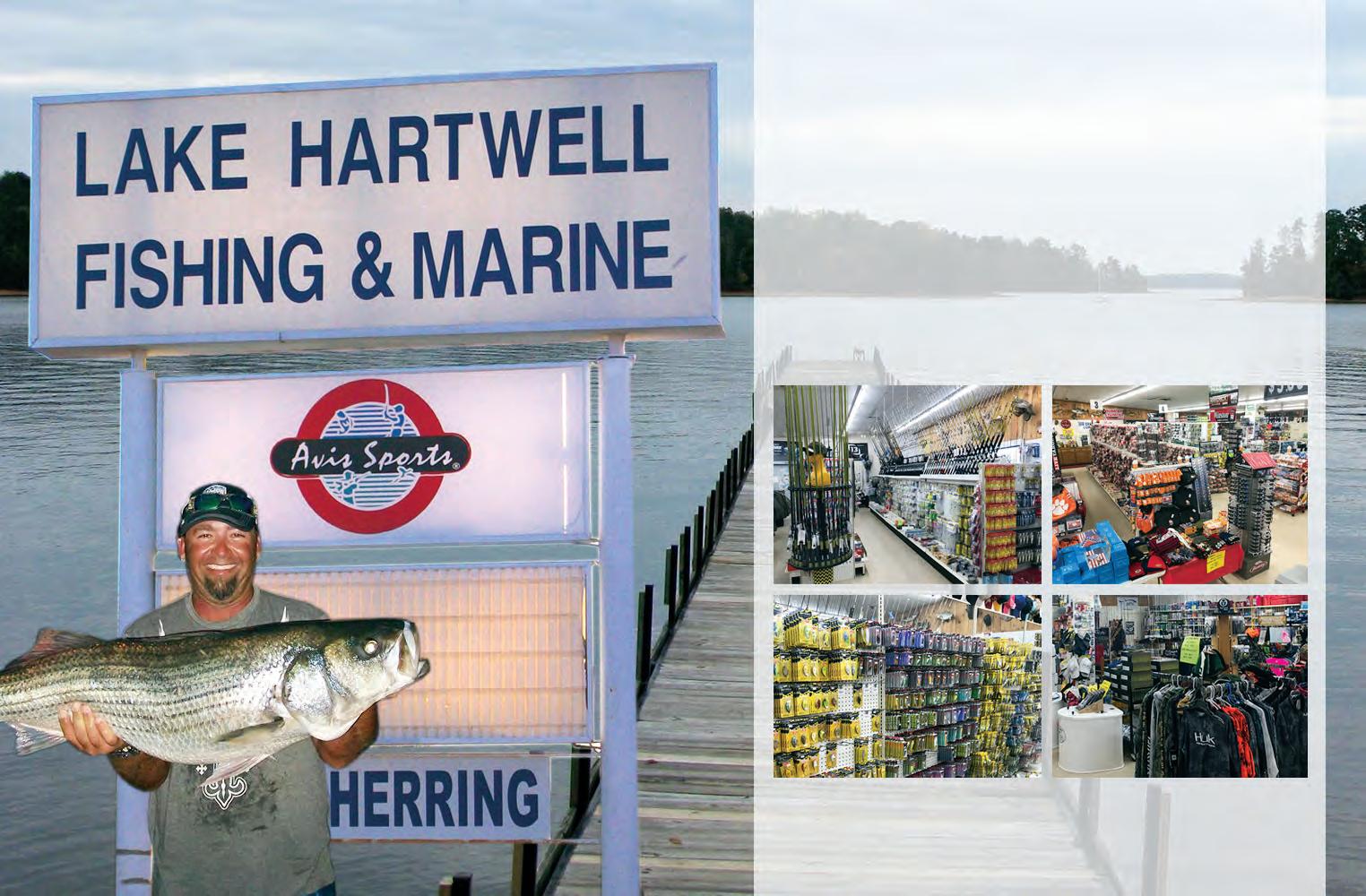
Here’s a memorable beach moment: You’re basking in the warm sun, toes in the sand, letting the gentle turn of the foam-capped waves lull you into a state of complete relaxation. As your eyes scan the endless horizon of blue on blue, you’re rewarded with a school of dolphins making their way across the sea. There’s no denying their signature shape as they leap from the water. If you don’t see anything else extraordinary the rest of the day, you can take solace knowing you’ve witnessed one of nature’s most playful and intelligent creatures in their natural habitat.
Why not re-create that special toes-in-the-sand moment with our Blue Topaz Dolphin Pendant? The beloved sea mammal has been captured mid-jump in sterling silver. And, tucked into its fins is a full two carats of shimmering blue topaz. Nothing captures the shimmering color of the ocean in the midday sun like blue topaz. With its sparkling clear blue color and high refractive index, blue topaz is one of the top-selling blue gemstones. And with our special price, you have quite the catch. Satisfaction guaranteed or your money back. Enjoy the Blue Topaz Dolphin Pendant for 30 days. If it doesn’t pass the test swimmingly, send it back for a full refund of the item price.

Limited Reserves. A full two carats of genuine blue topaz set in sterling silver for this price is as rare as a dolphin sighting. We cannot guarantee availability for long. Call today!


Stauer… Afford the Extraordinary ®



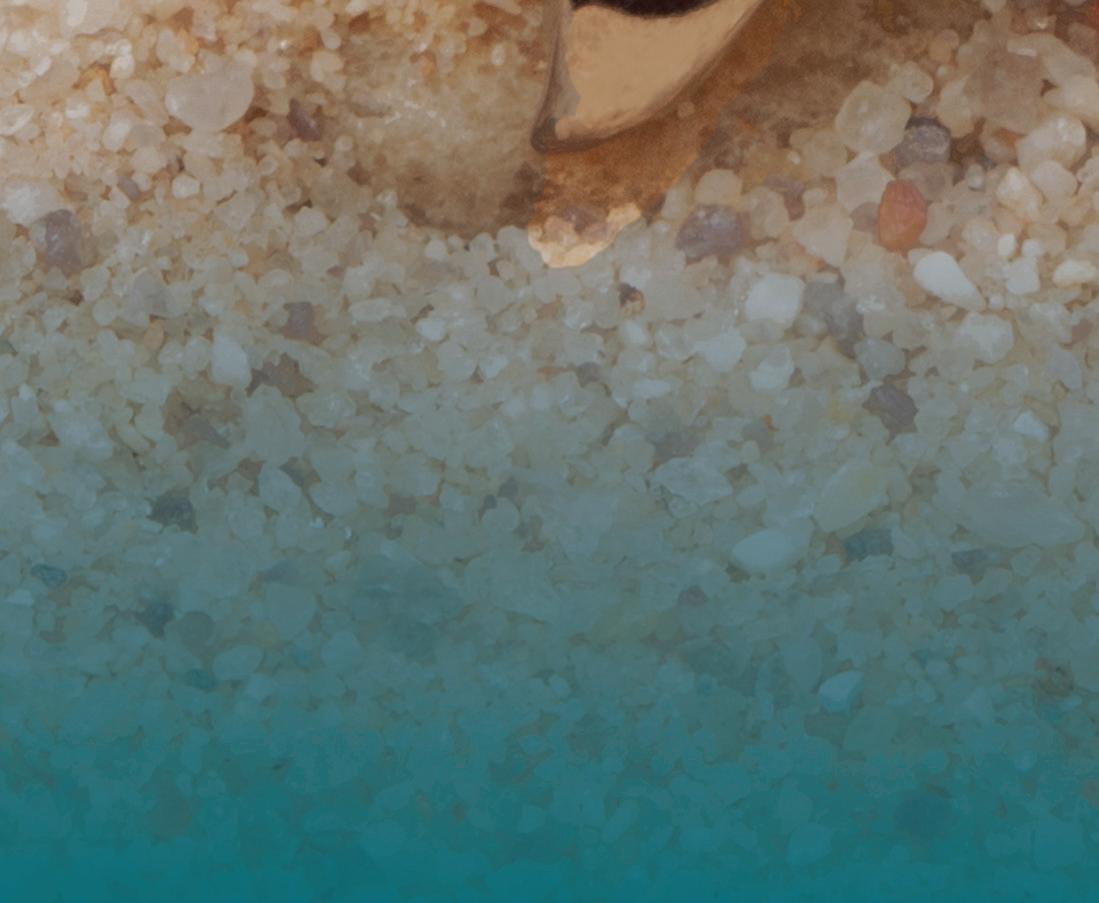
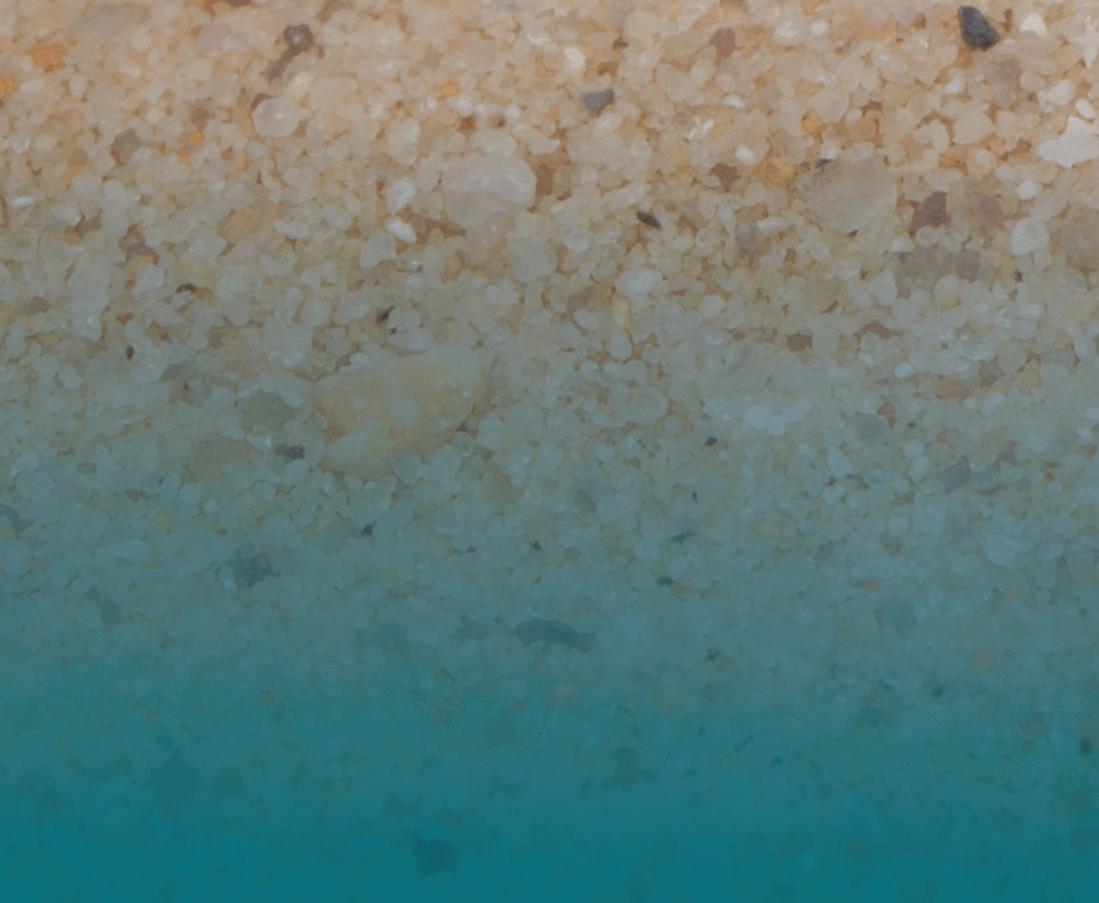

The 2023 Academy Sports + Outdoors Bassmaster Classic—widely known as the “Super Bowl of Bass Fishing”—will be held March 24-26 in downtown Knoxville, Tennessee and on the University of Tennessee Campus.
e Bassmaster Classic is one of the world’s most prestigious championship tournaments and pits 55 of the world’s best bass anglers against one another for the title of Bassmaster Classic Champion. e Classic is a catch-and-release event, with bass being returned to the shery under the supervision of the TWRA.


Daily takeo s will be from Volunteer Landing on the Tennessee River in downtown Knoxville each competition day, and weigh-ins will take place in the ompson-Boling Arena on the University of Tennessee campus. e fan favorite Bassmaster Classic Outdoors Expo will be held Friday through Sunday, March 24-26 in the Knoxville Convention Center and the adjacent World’s Fair Exhibition Hall.
All activities and venues are free and open to the public.
For more information, visit Bassmaster.com.
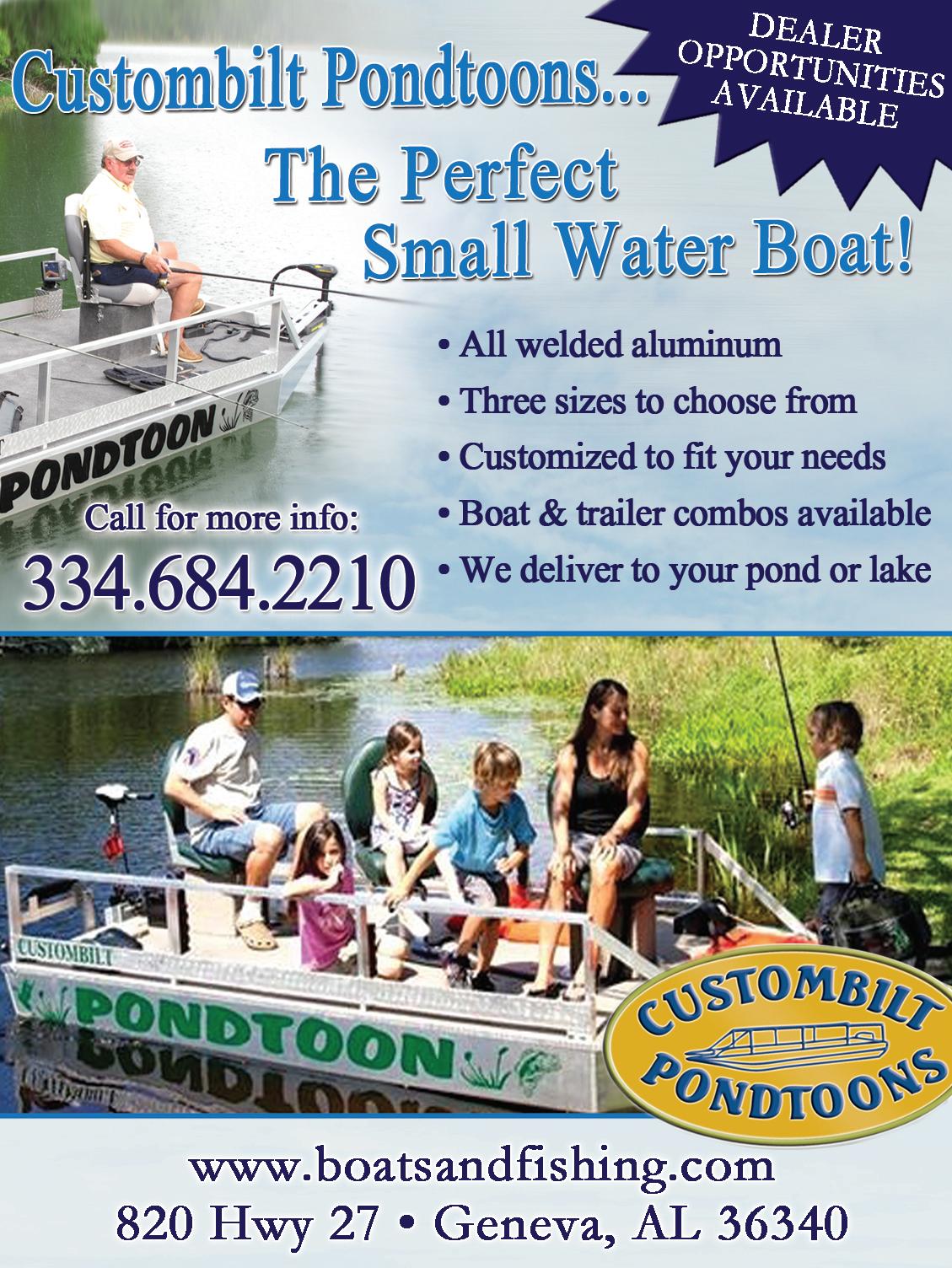
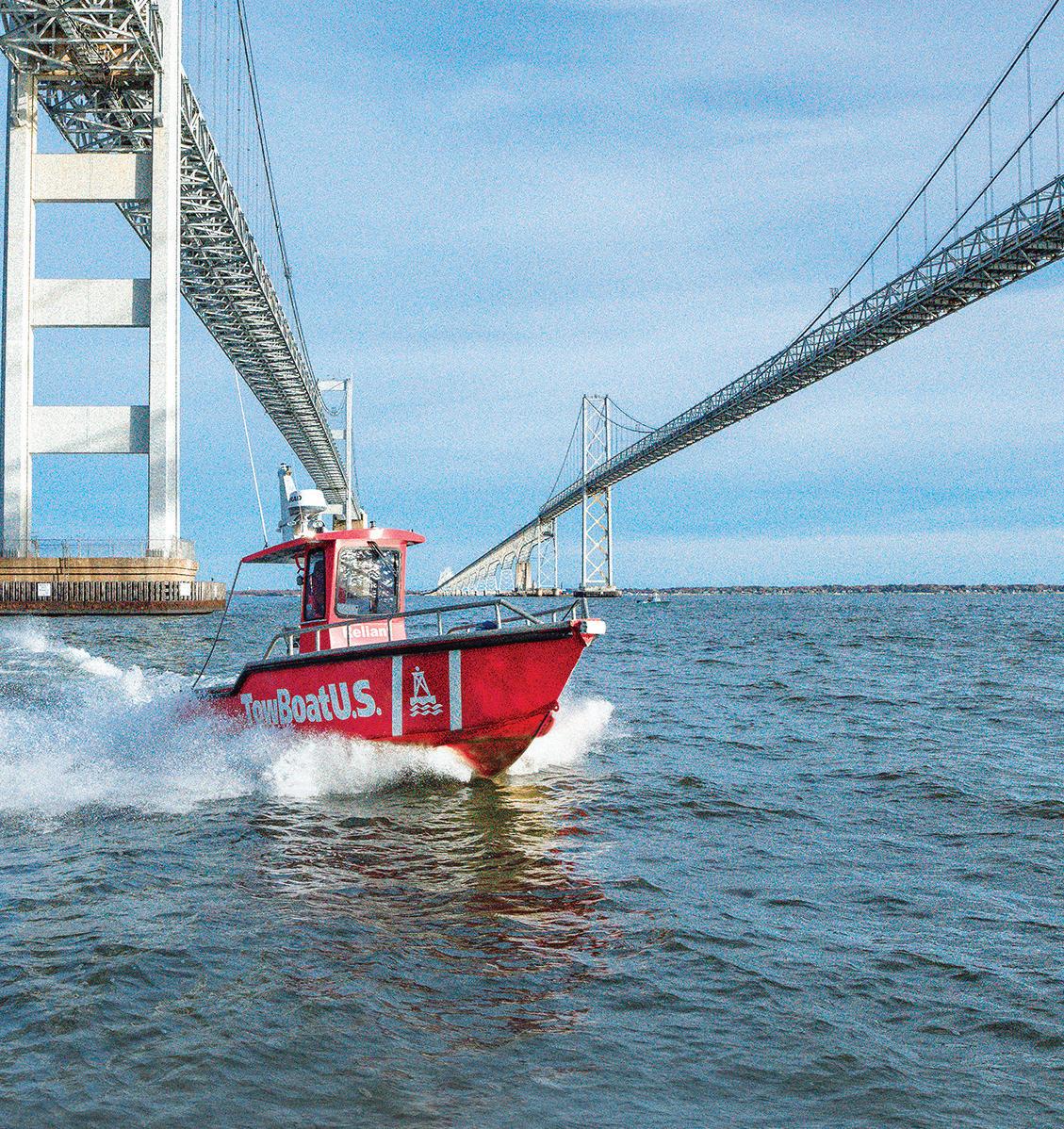



C-Hawk Boats has made a name for itself among boaters who want no-nonsense, custom-purpose vessels that are designed to perform and built to last. Owner Brad Grubbs said their C-Hawk 25 Center Console is an endlessly customizable boat that has gained a lot of fans among charter captains who fsh them hard every day. “We have 10-plus guides using them on the west coast of Florida,” he said. “In Georgia and South Carolina, they’re using it as a small passenger ferry. In Chesapeake Bay, it’s a crab boat.”

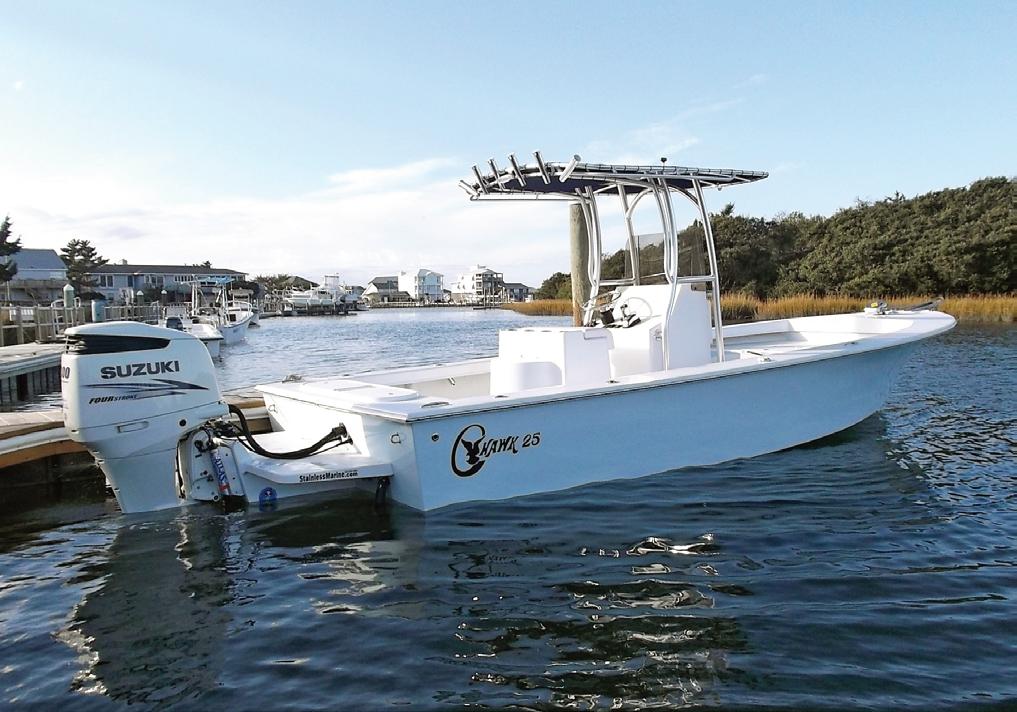
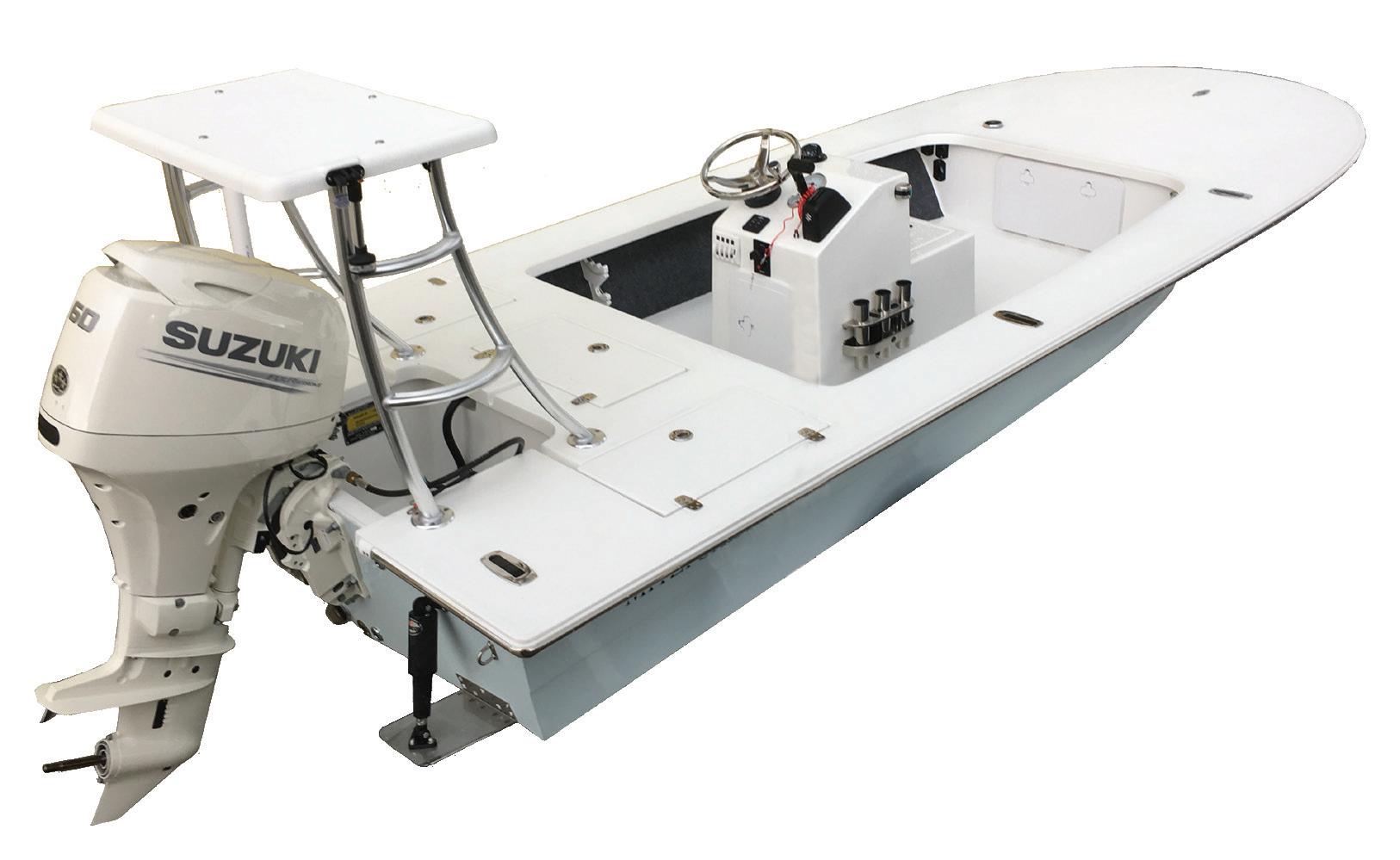

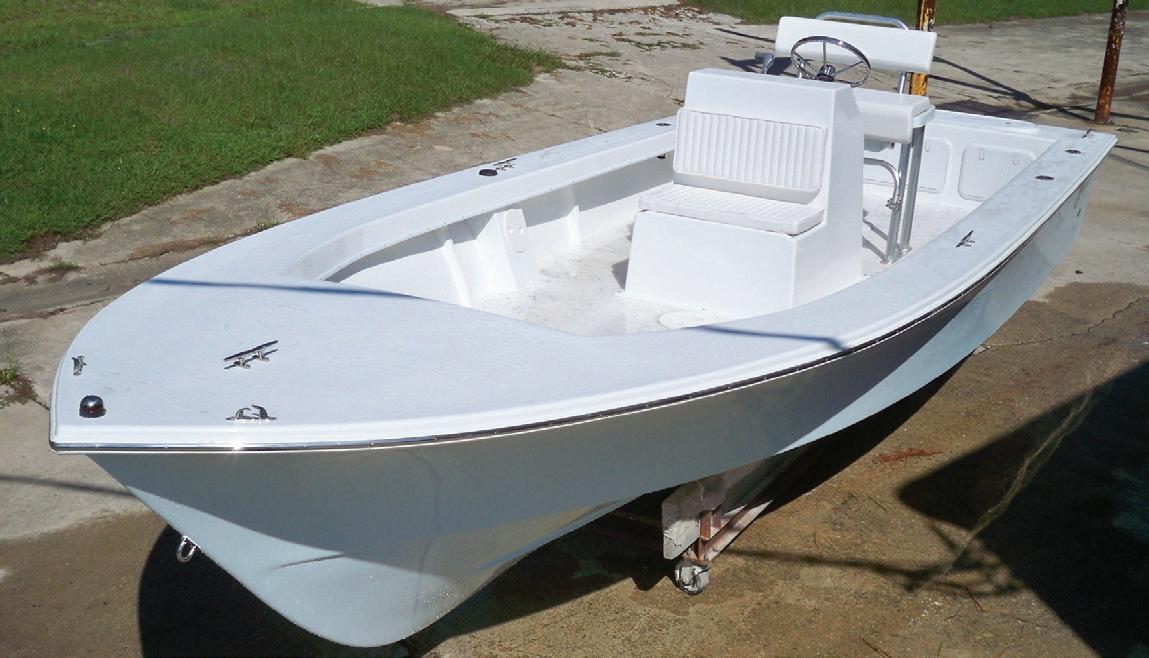

At its core, the C-Hawk 25cc is a hard-core workhorse with a 300 horsepower maximum that will take you anywhere you need to go. Its 9’6” beam allows it to foat in very skinny water with just a 12” draft, and it is also extremely stable, which should appeal for bottomfshing, diving and any other pursuit where a stable platform is preferred. Whatever you plan to do with it, all C-Hawk boats are built battleship tough to commercial-application standards. They are designed to withstand hard use for years of trouble-free boating, and you can customize your C-Hawk from the factory in any way that suits your purpose.
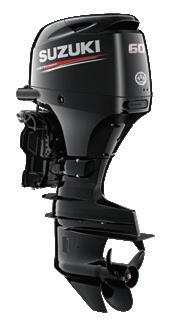
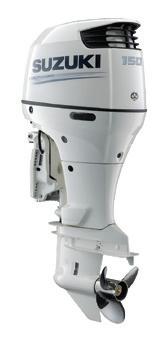

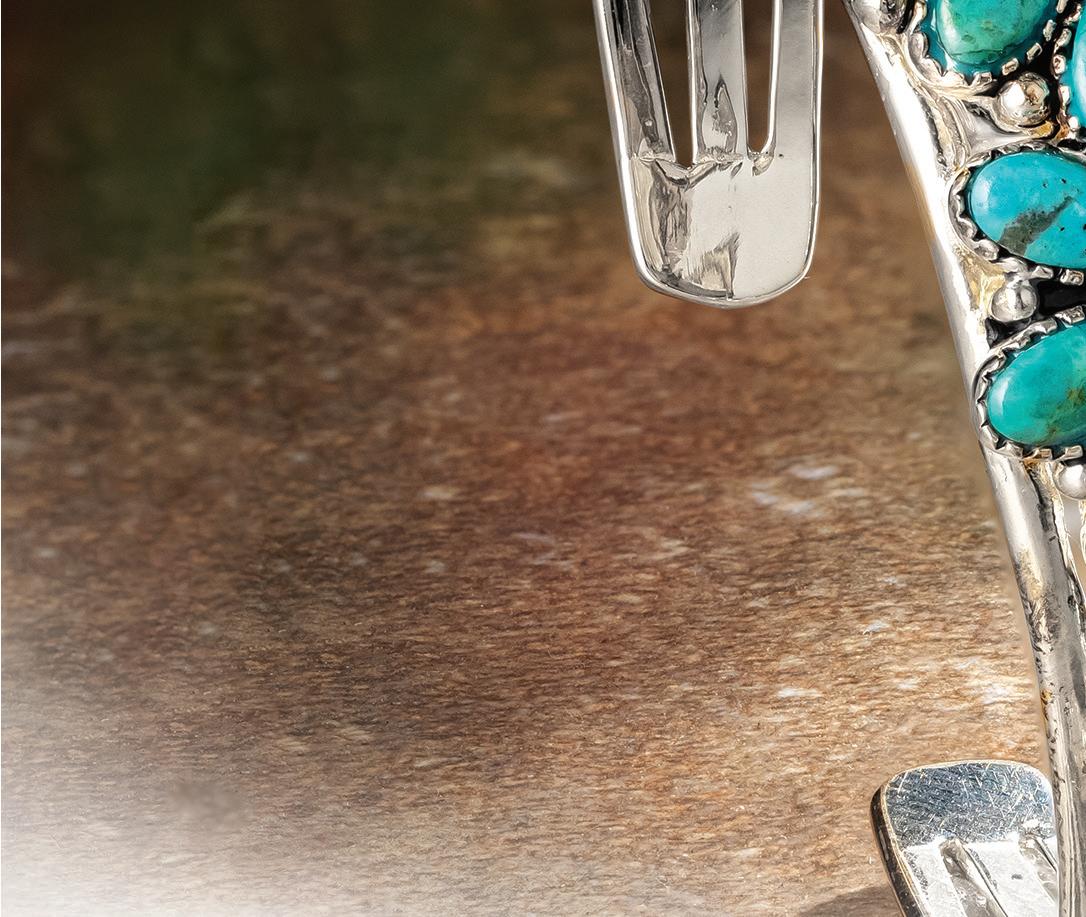
“We can mix and match consoles, fsh boxes, full transoms, cut transoms, bare hulls… you name it,” Grubbs said. “There are some recreational guys adding towers and sight fshing for cobia, and such. Everything we do is built around keep it simple, keep it effcient, keep it easy to maintain, keep it cost effective to own and operate. They are all unique… no cookie cutter trailer queens here. The 25 is a great example of what C-Hawk is.”

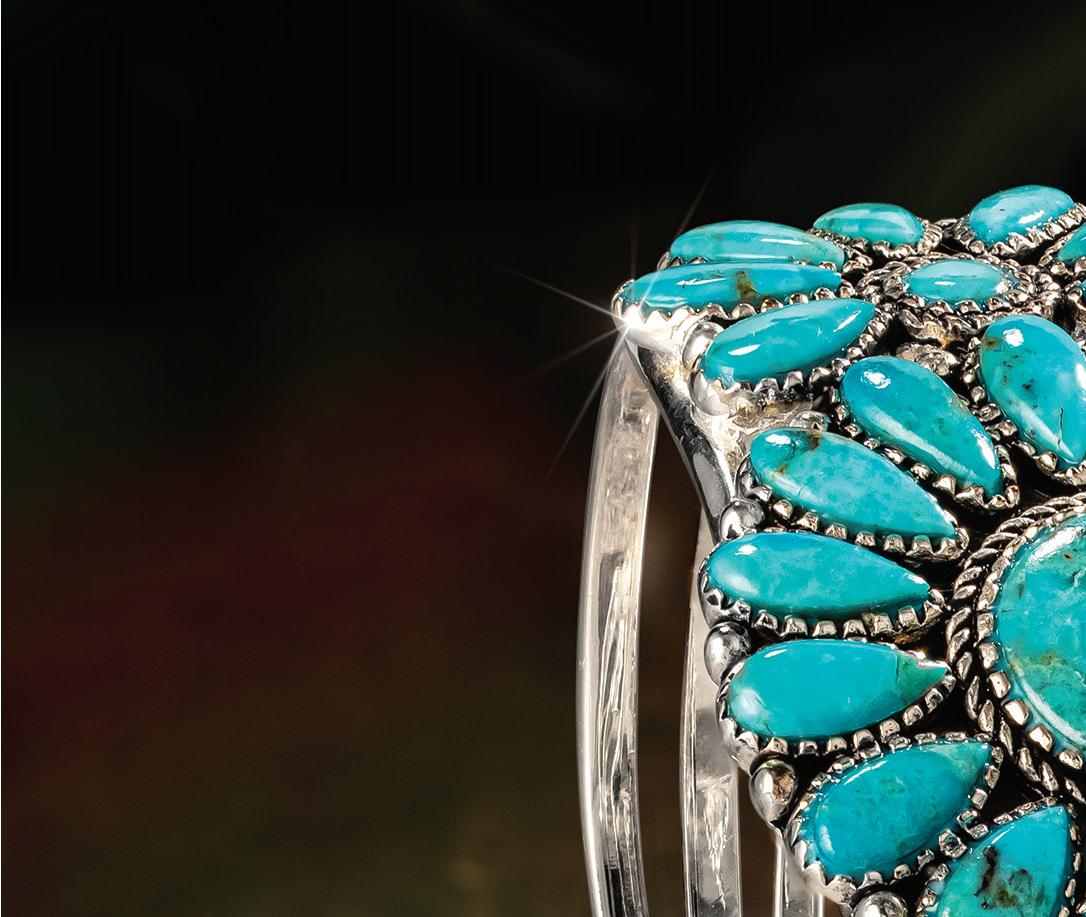
Old Pete was a retired stuntman bursting with stories. There was the time he stared down a grizzly bear. There was the time he won a competition and got to kiss a Hollywood starlet as the prize. And there was the time he got into a fistfight with the Duke. Many stories. Some were probably even true. I know two things for sure: that he had an excellent collection of turquoise and that he owed me for a poker game he lost. The last time I saw him, he opened a drawer and pulled out a collection of beautiful Navajo turquoise jewelry to repay his debt. Pete’s jewelry inspired our Tucson Sun Turquoise Collection. This jewelry set features turquoise that’s been gently enhanced to bring out its finest shades in a Southwestern motif. Finished with oxidized silver, this jewelry set captures the beauty and mystery of the Arizona desert. The rarest and most valuable turquoise is found right here in the American Southwest, but the future of the blue beauty is unclear. I recently spoke with turquoise traders who explained that less than 5% of turquoise mined worldwide can be set into jewelry. Once thriving, many Southwest mines have closed.
But Stauer saw this coming and is now one of the largest owners of gem-grade turquoise in the U.S. Don’t miss your chance to own the diamond of the desert. Act now. This is one of our fastest sellers, and we only have a limited supply of Arizona turquoise available for this ad. See why Stauer remains the best bang for your buck!

Jewelry Speci cations:


• Arizona turquoise. Oxidized silver finish. Ring: whole sizes 5-10. Pendant: 1 ¾" drop. Cuff: fits wrist to 7 ¼".





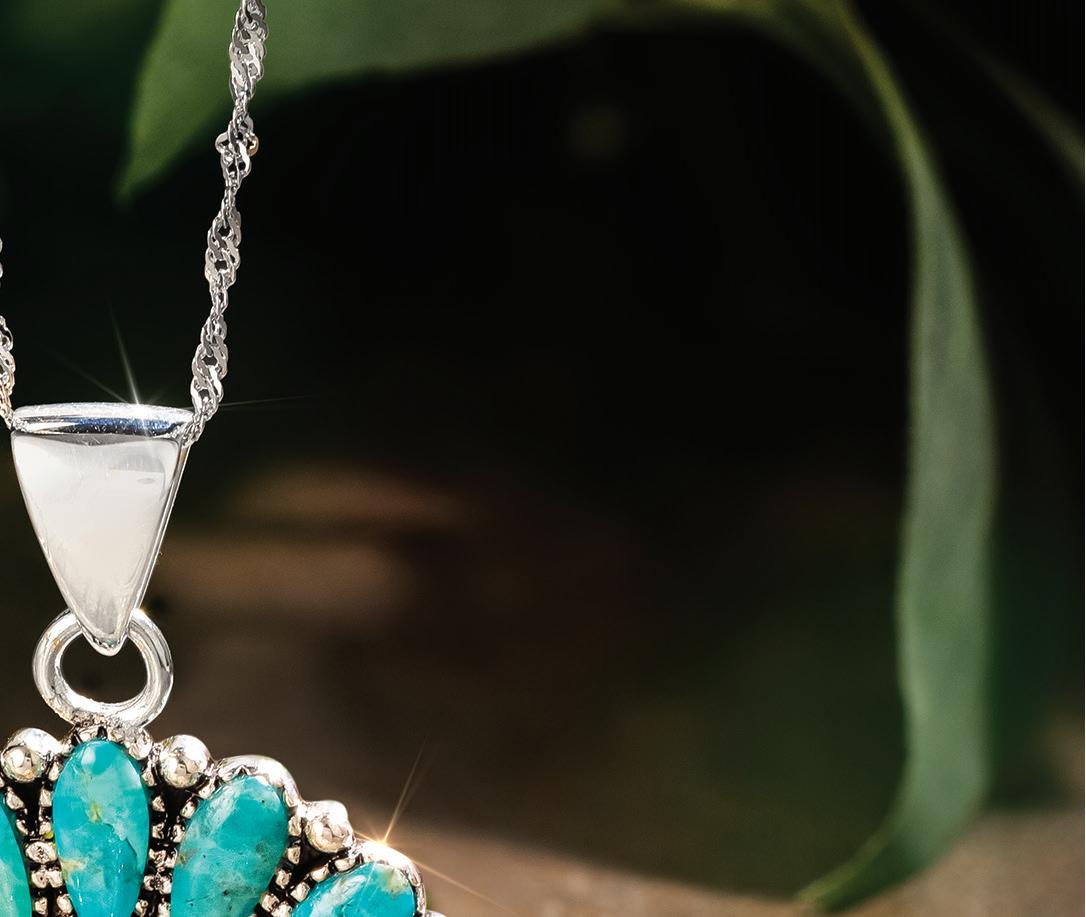
Stauer, 14101 Southcross Drive W., Ste 155, Dept. TSC130-01, Burnsville, MN 55337 www.stauer.com

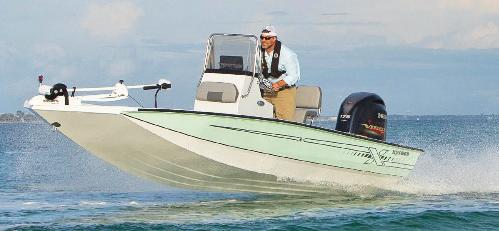

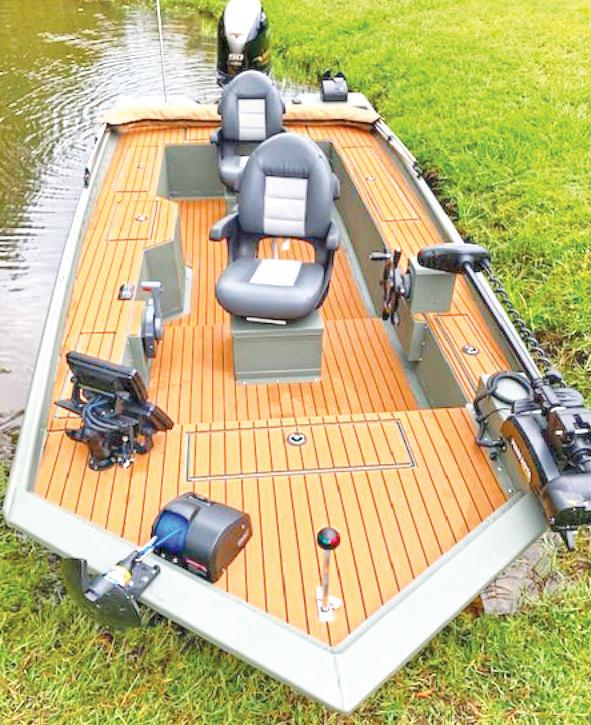



Introduced in the New Product Showcase at ICAST 2022, the all-new MHX HD Rod Rack is the ultimate shing rod storage system with space for up to 20 of your favorite rods.
Constructed from Marine Grade HDPE material, it will never rot, warp or damage your tackle. Assembled with stainless steel hardware, no environment is o limits. Whether used on the dock for a post-trip wash down or just to help organize your garage and tackle room, this rod rack is a solid piece of equipment designed for serious anglers.


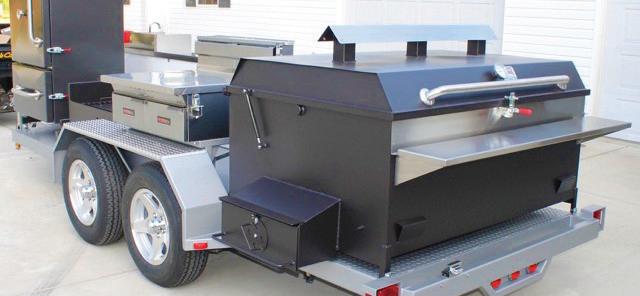
From y and light-tackle rods to heavy o shore rods, each rod’s ghting butt sits in CNC Milled recessed cups to add stability to all handle styles. e MHX HD Rod Rack has the size and the brawn to handle your full arsenal, indoors or outside. It even comes with four supports that lock in heavy duty bent butt o shore rods.

Measuring 26” x 16” x 8”, this heavy-duty, multi-purpose rod rack is easy to assemble and will nd a perfect place on your boat or dock, in the garage, or at the shop.
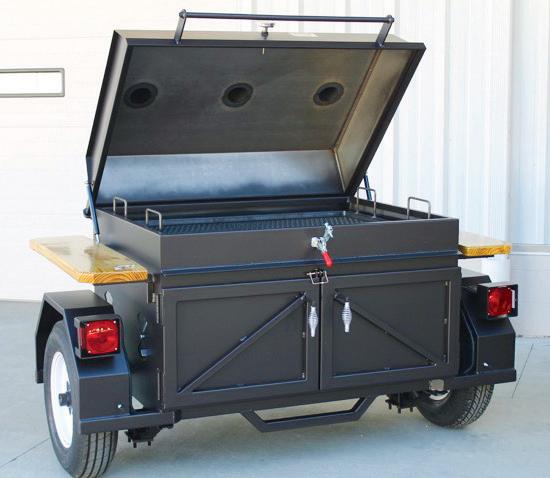

e MHX Rod Rack securely stores your rods, so they are ready at a moment’s notice. With an MSRP of only $229.95, you won’t nd a tougher, more versatile rod rack at such an amazing price. Shop for the MHX HD Rod Rack at mudhole.com today!




Berkeley County is a wonderland for outdoor enthusiasts, sports bu s, adventure seekers, and water lovers.


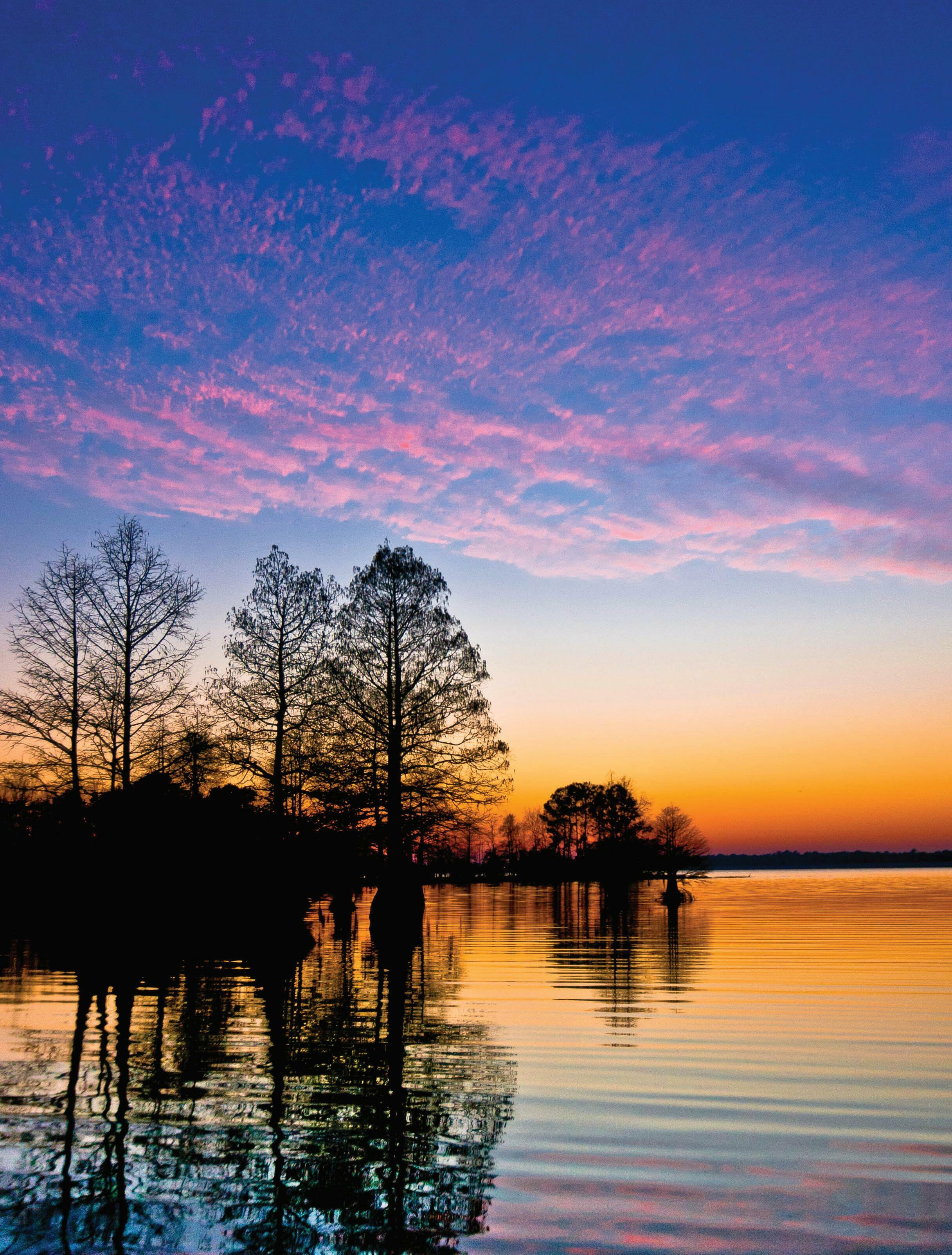
From exemplary fishing for striped bass, or a trophy largemouth bass, to our hiking trails and water activities, along with scenic outdoors where you can catch a glimpse of white tail deer and gators, Berkeley County has activities to fit all visitors and families.

Learn more about Berkeley County at: exploreberkeleycounty.com

